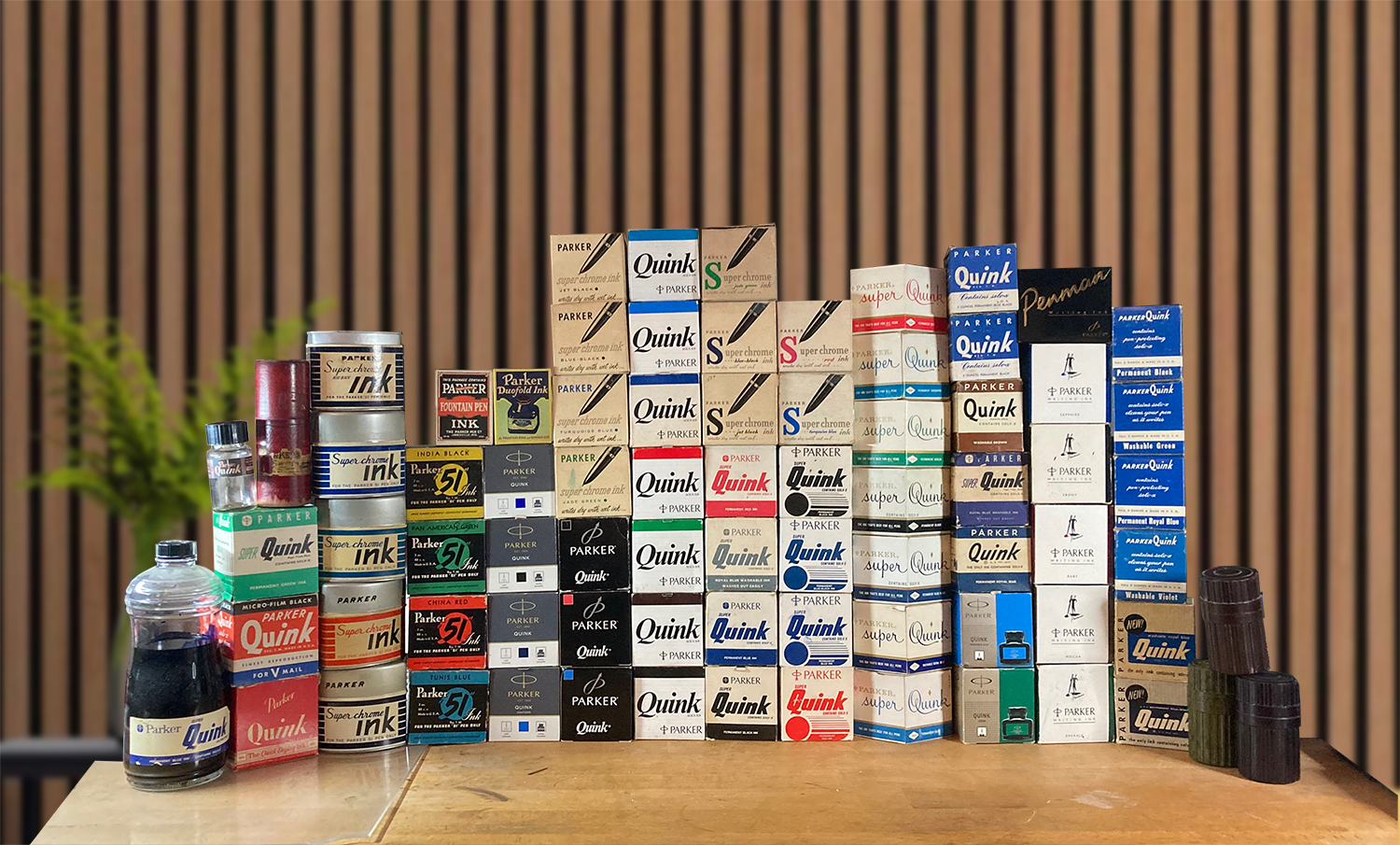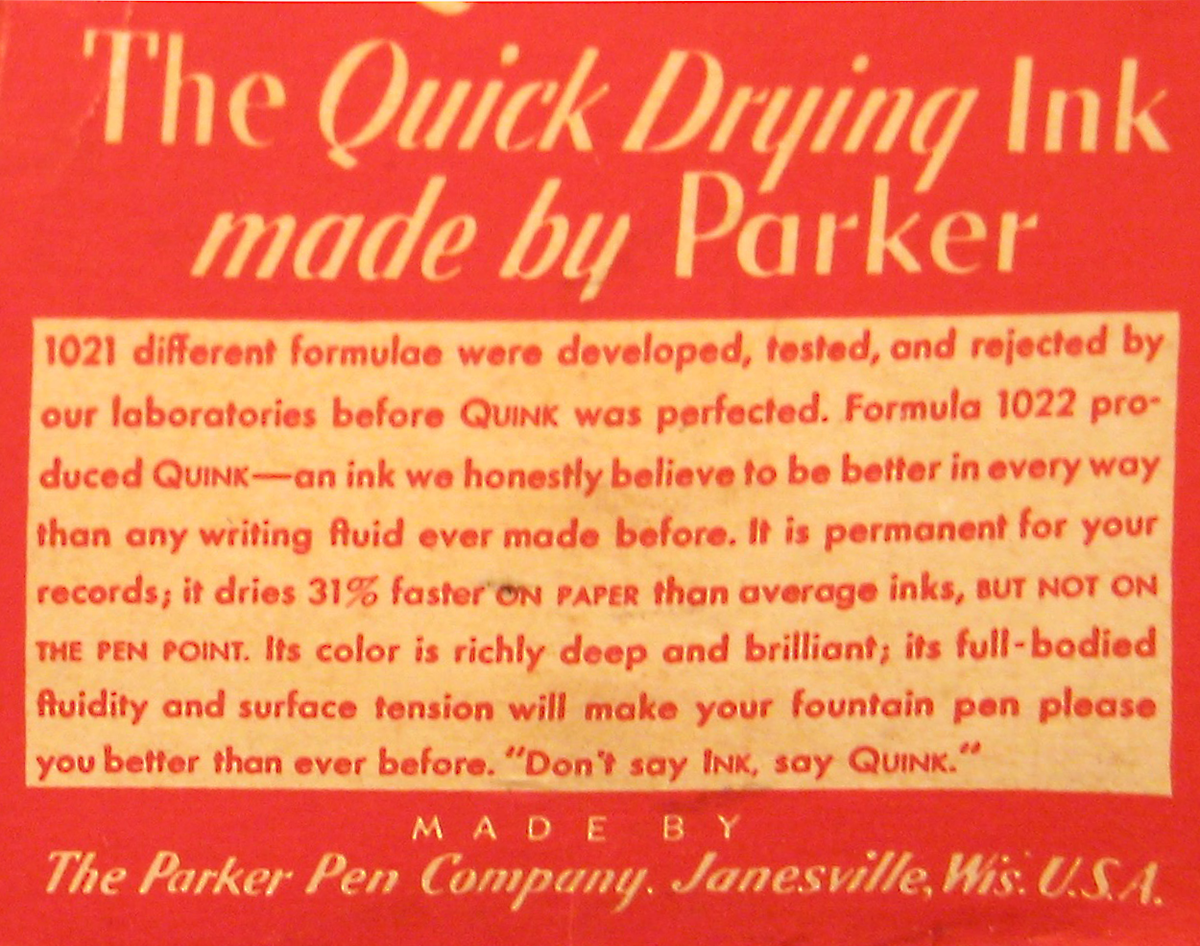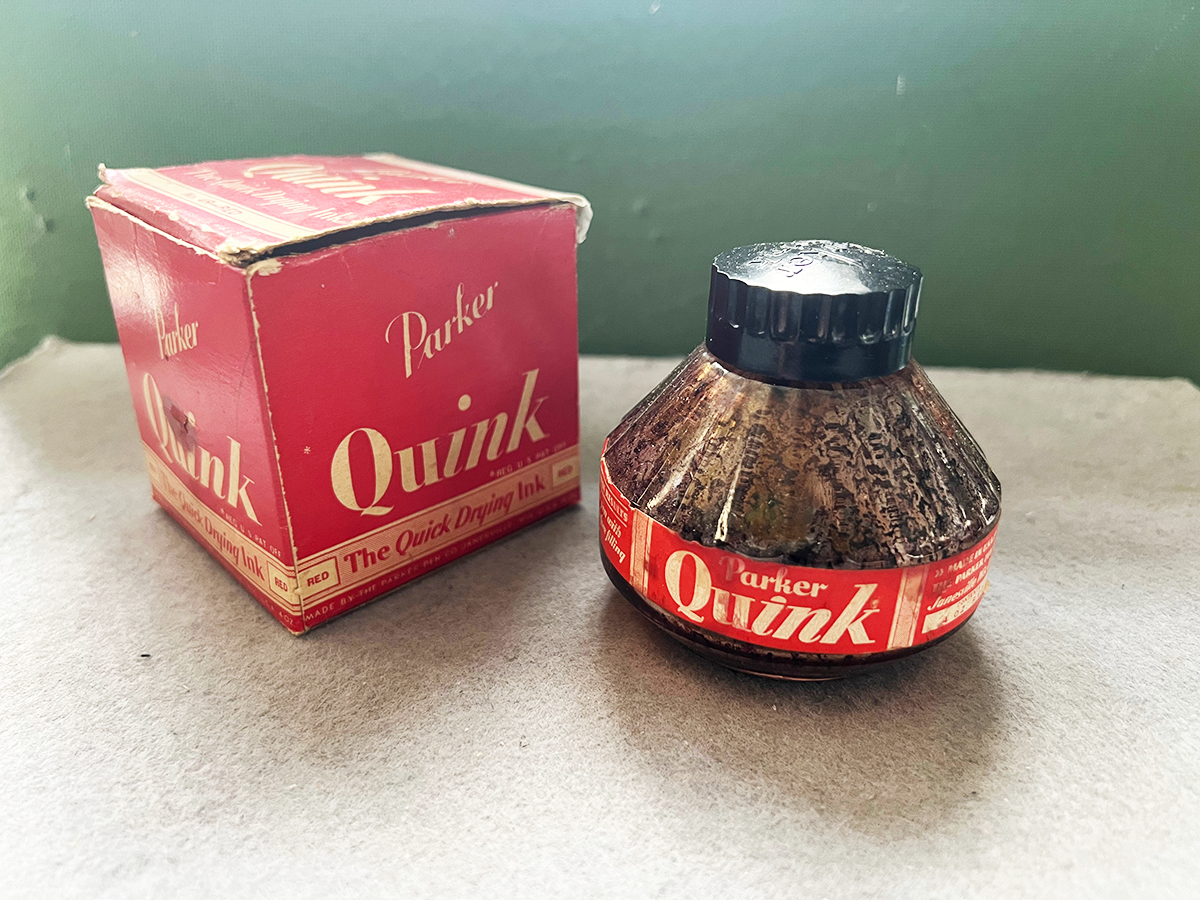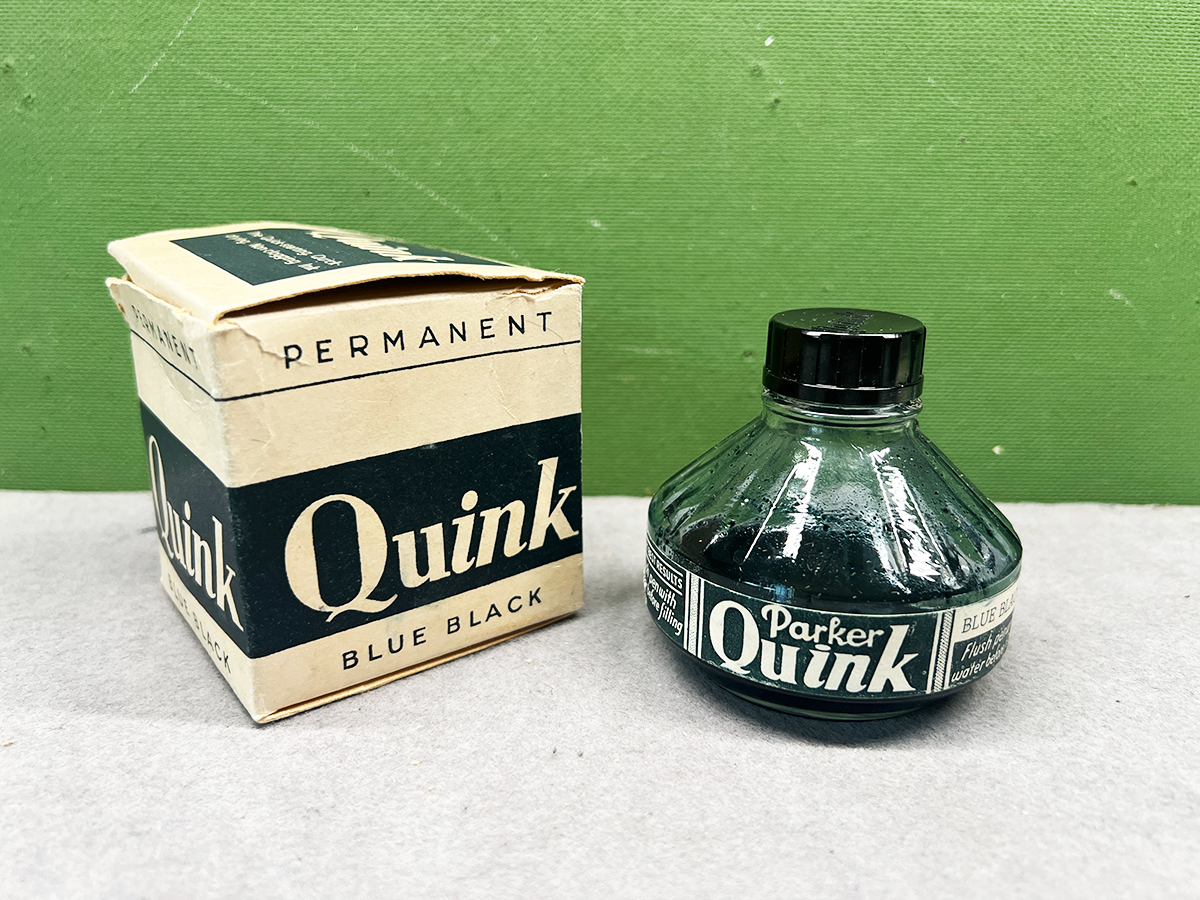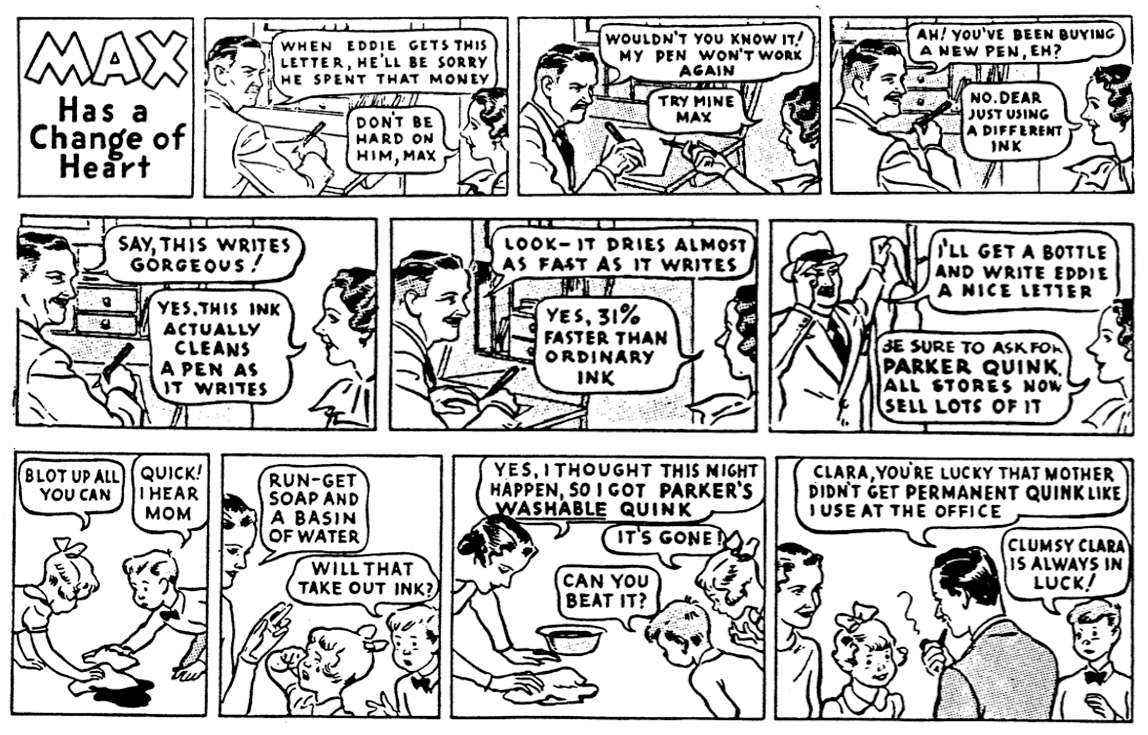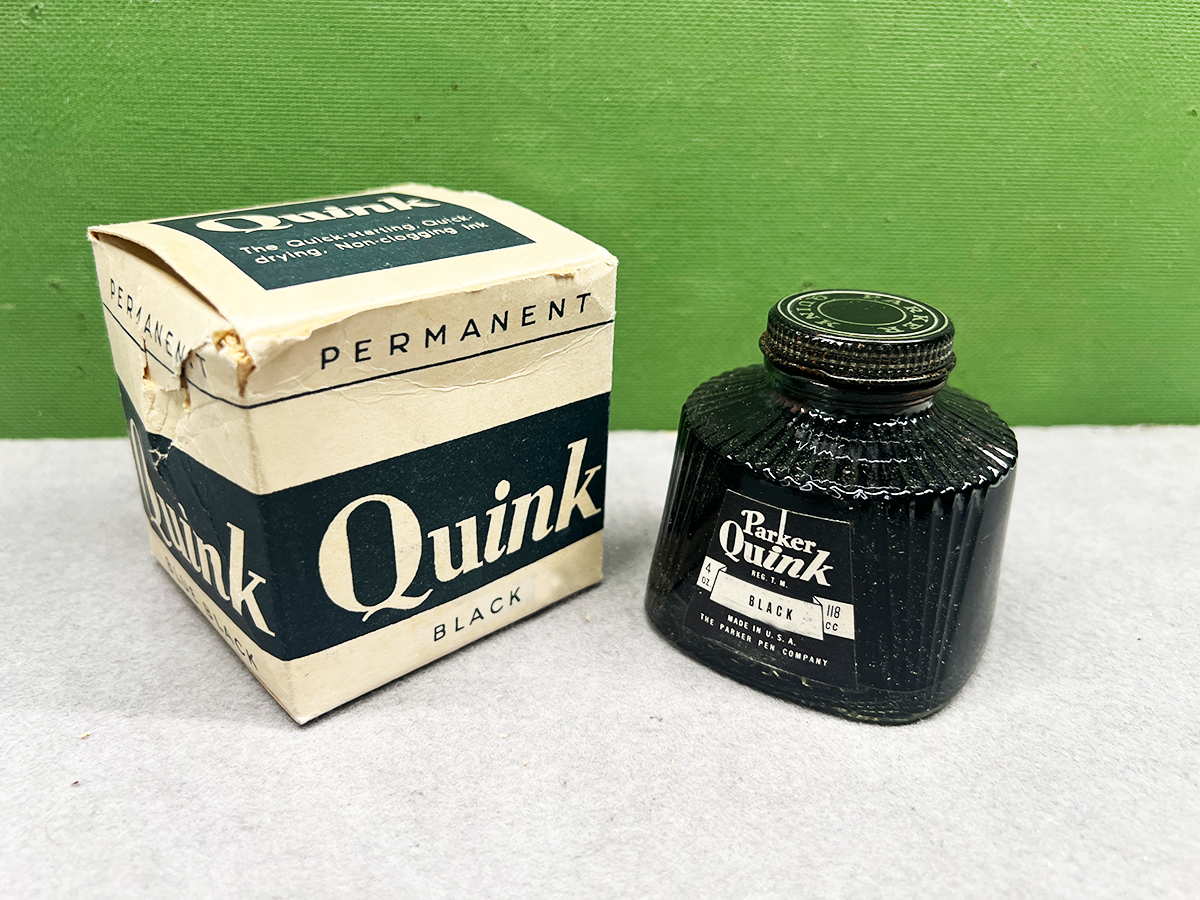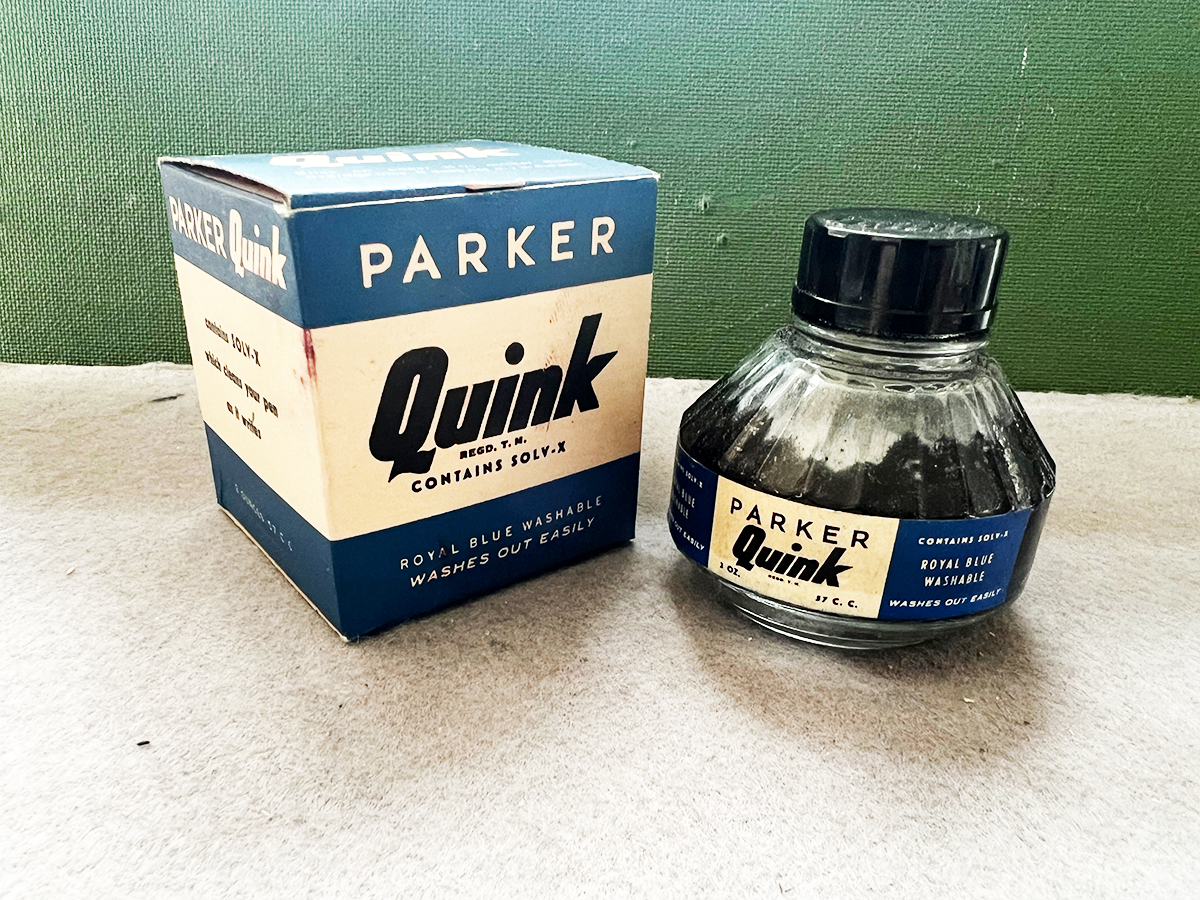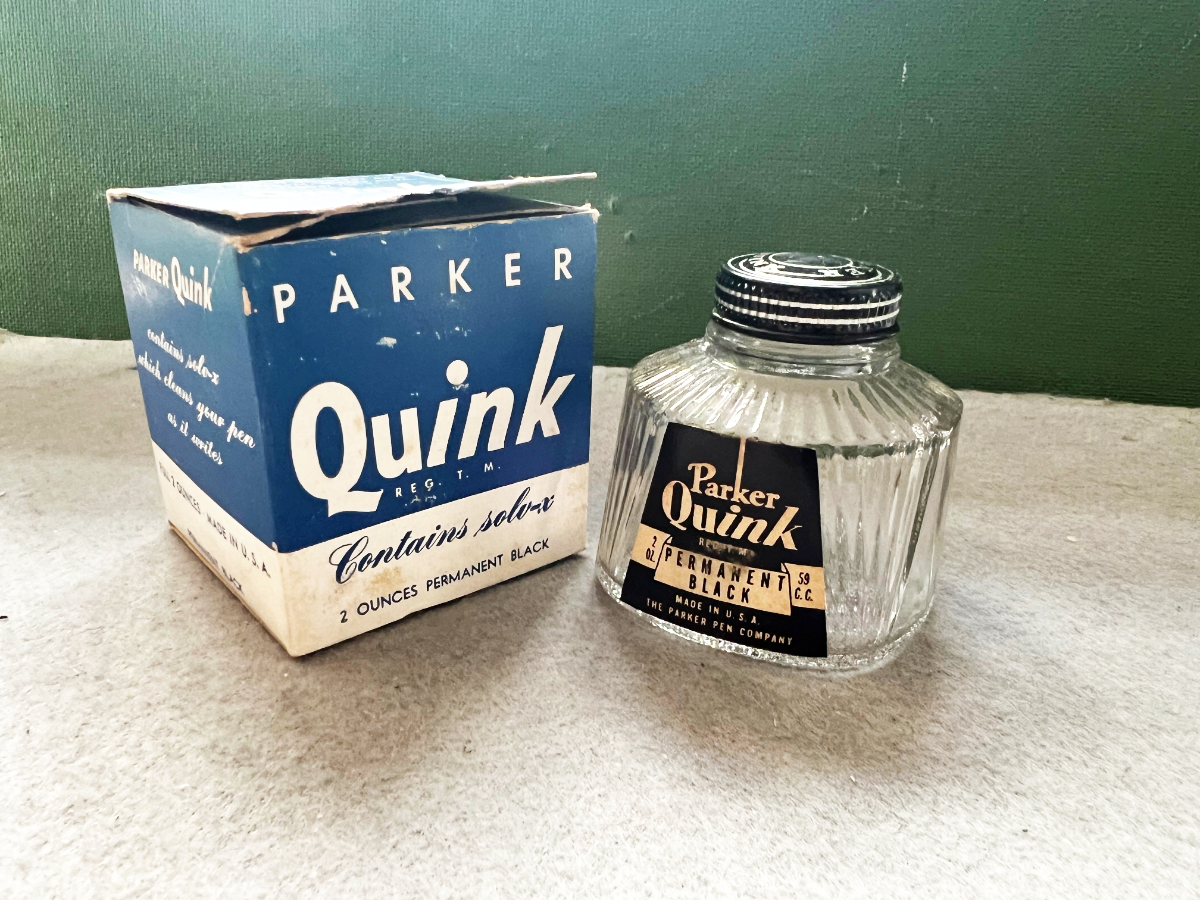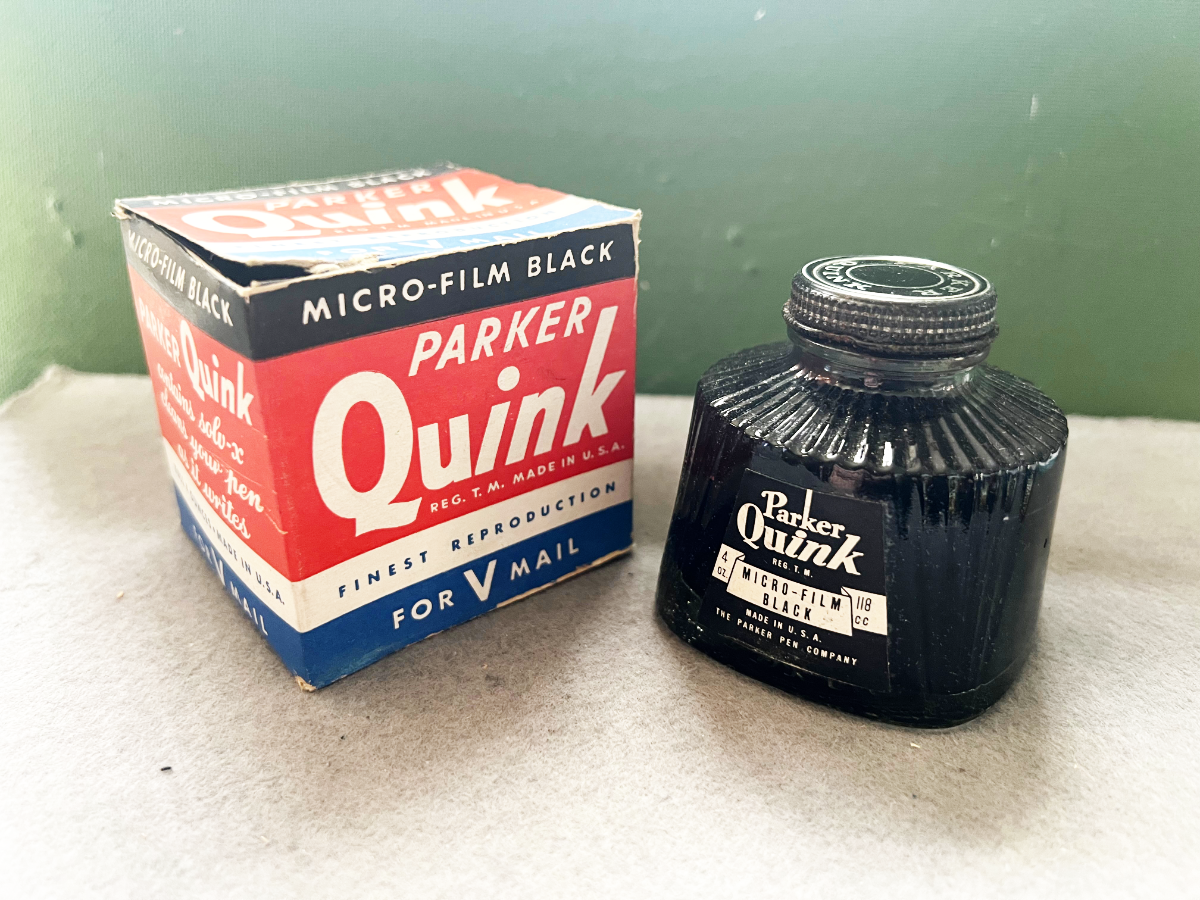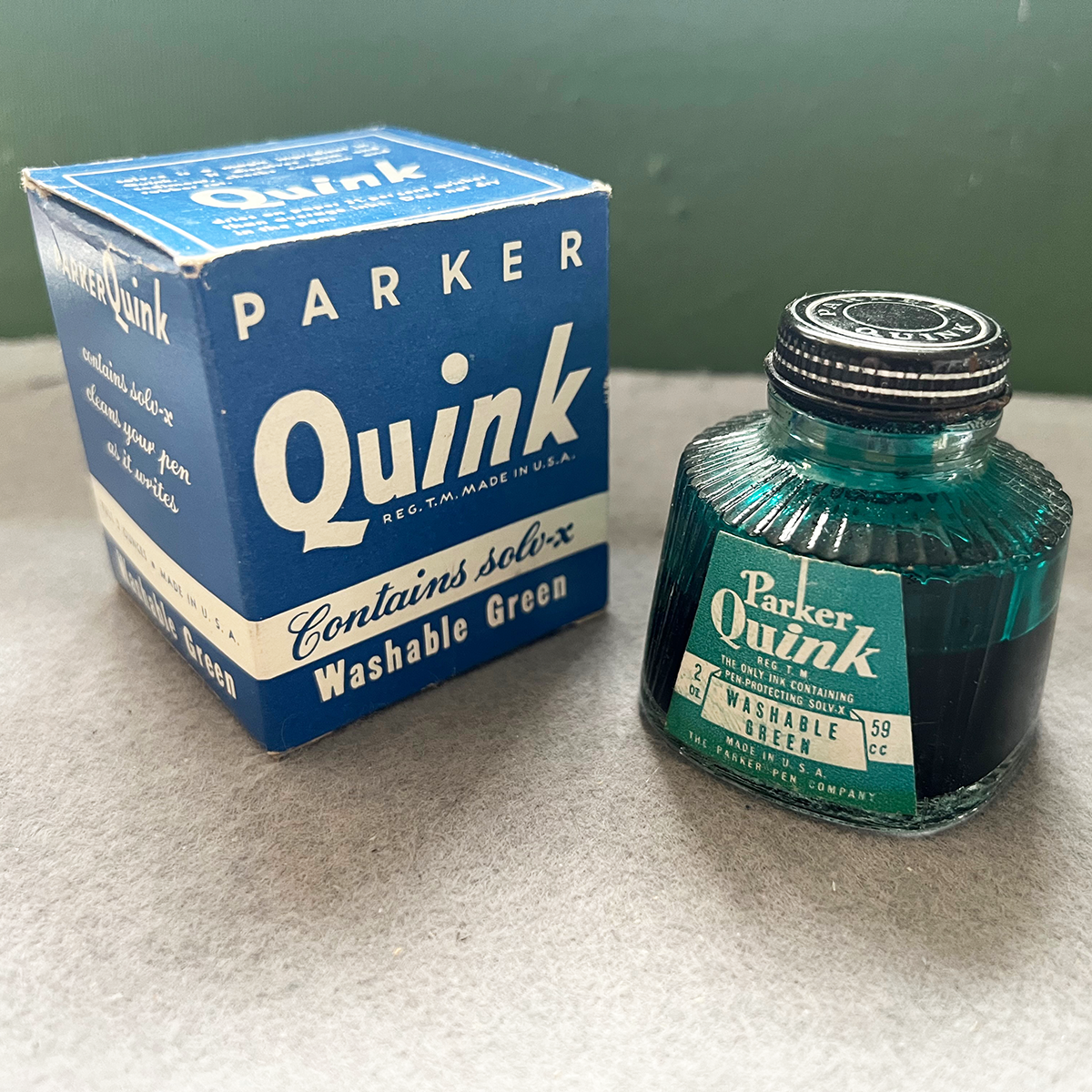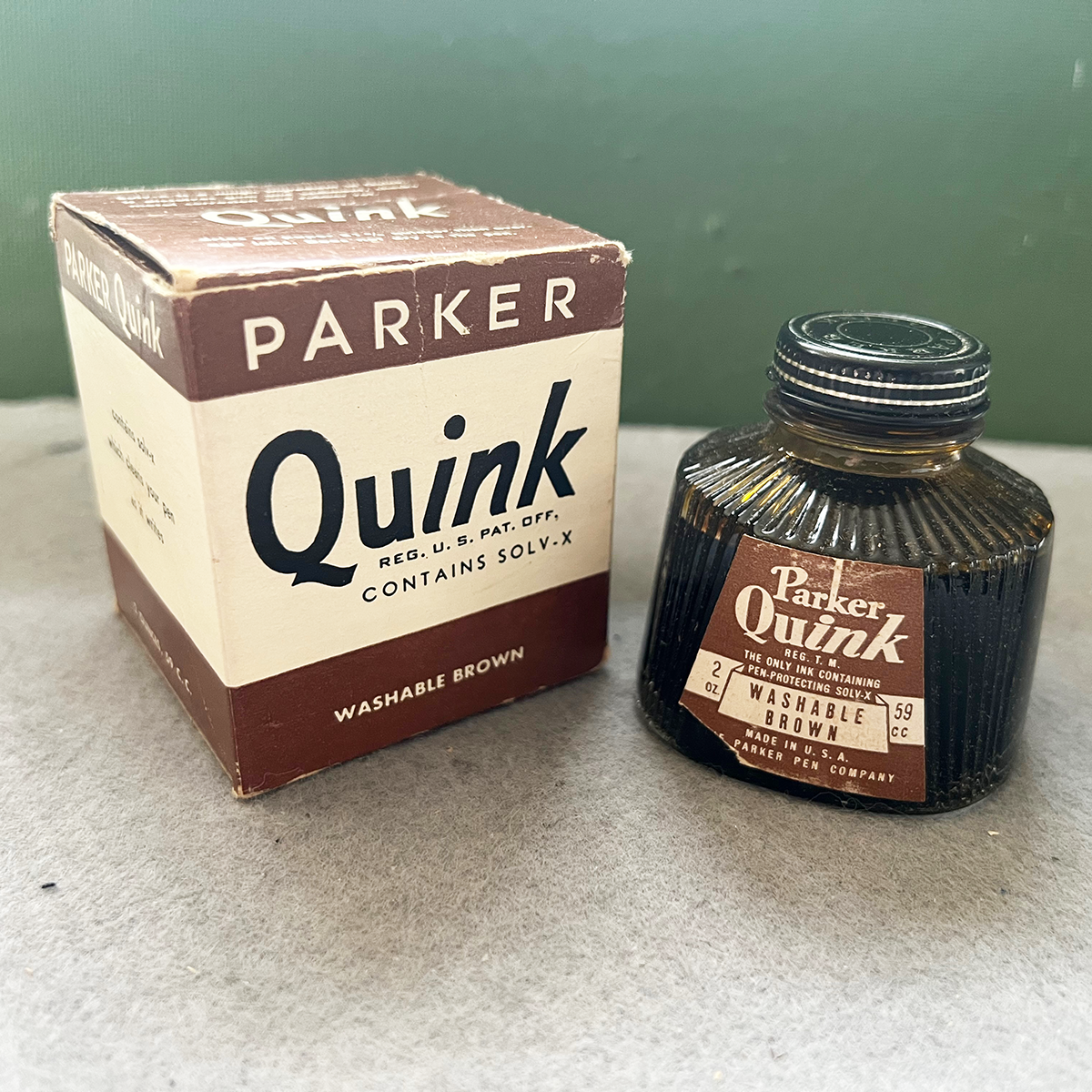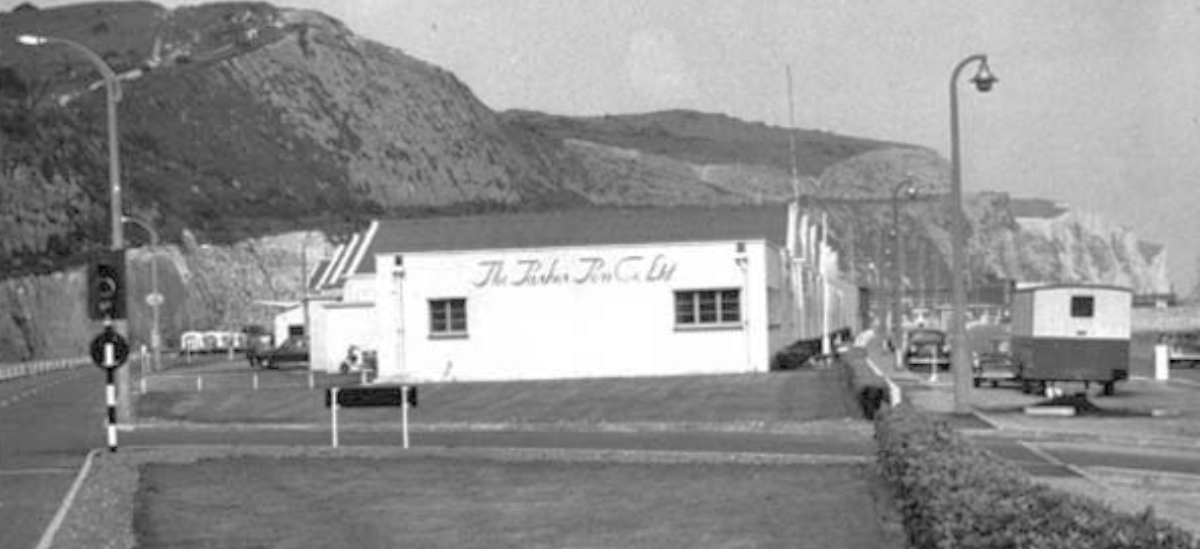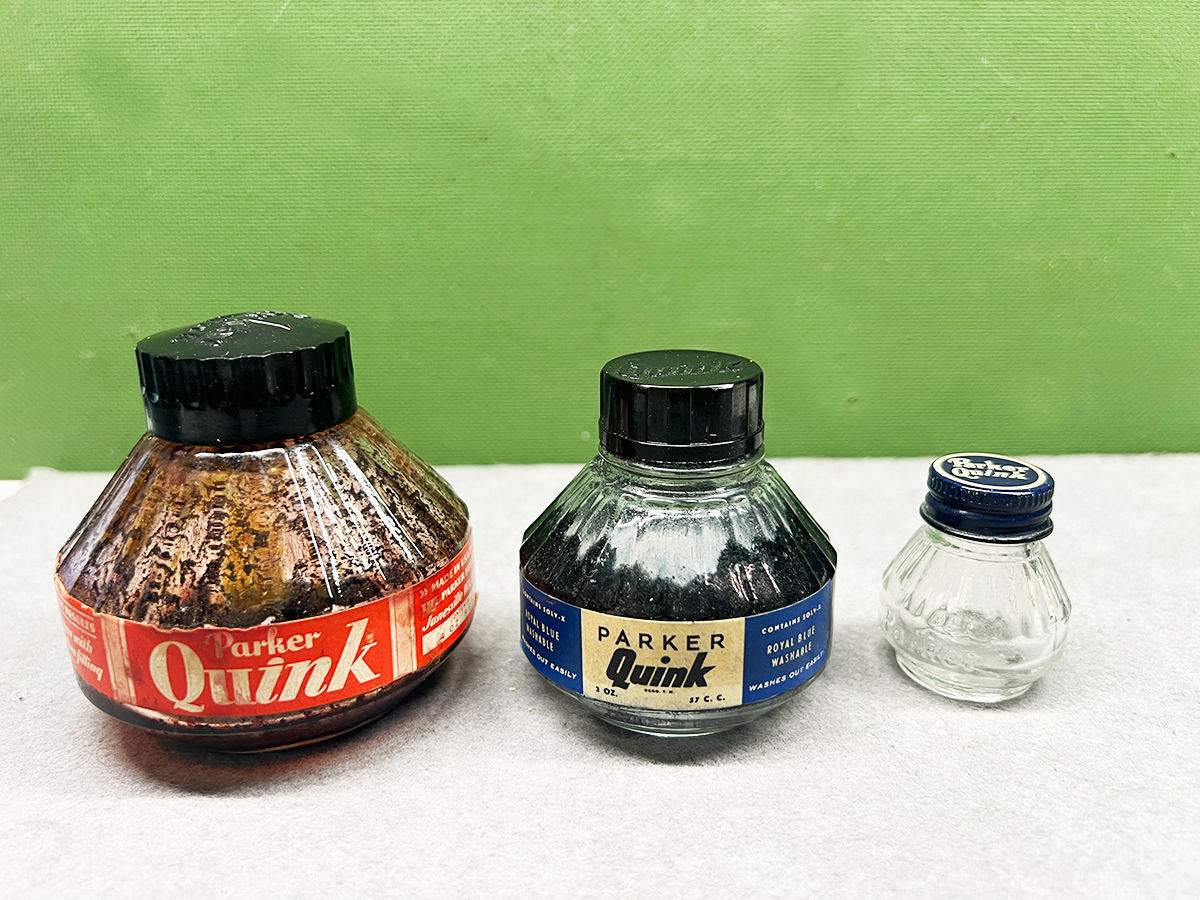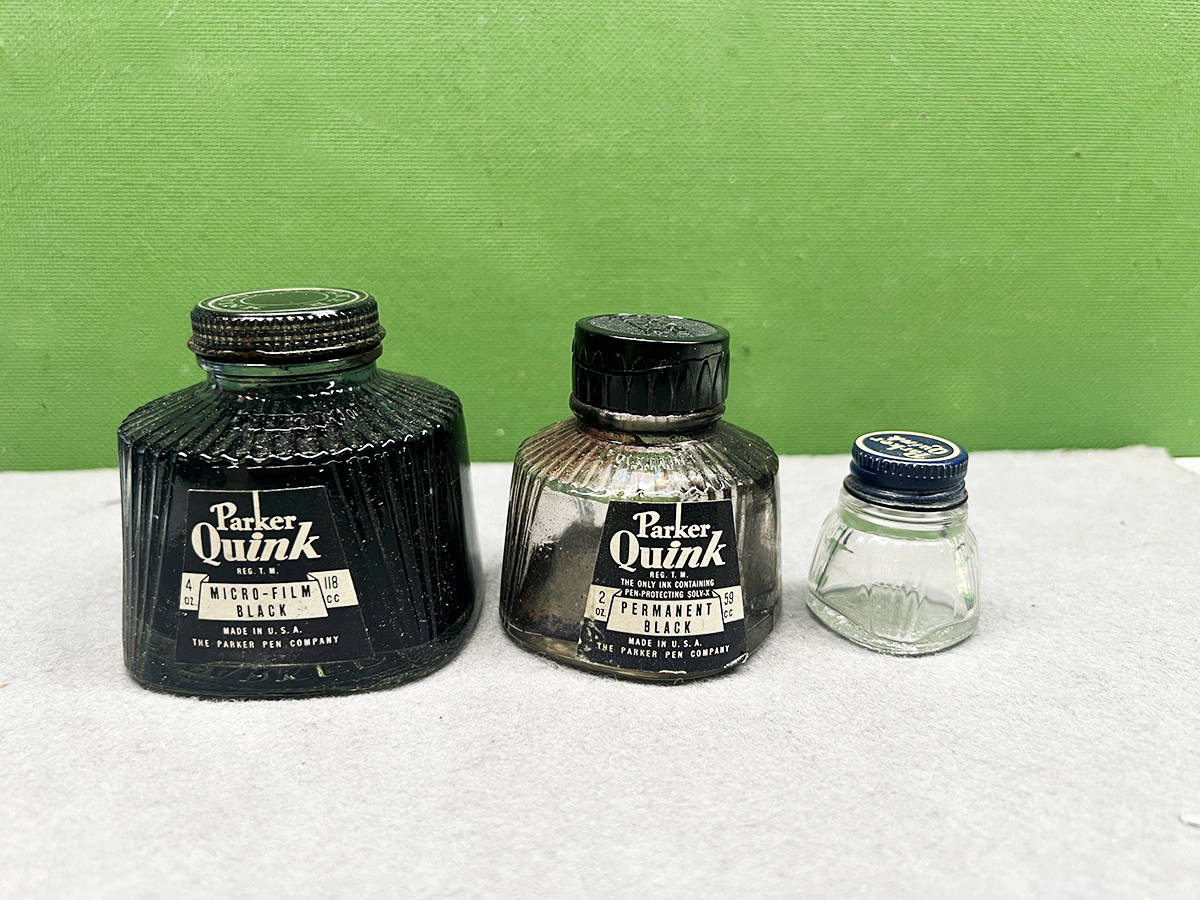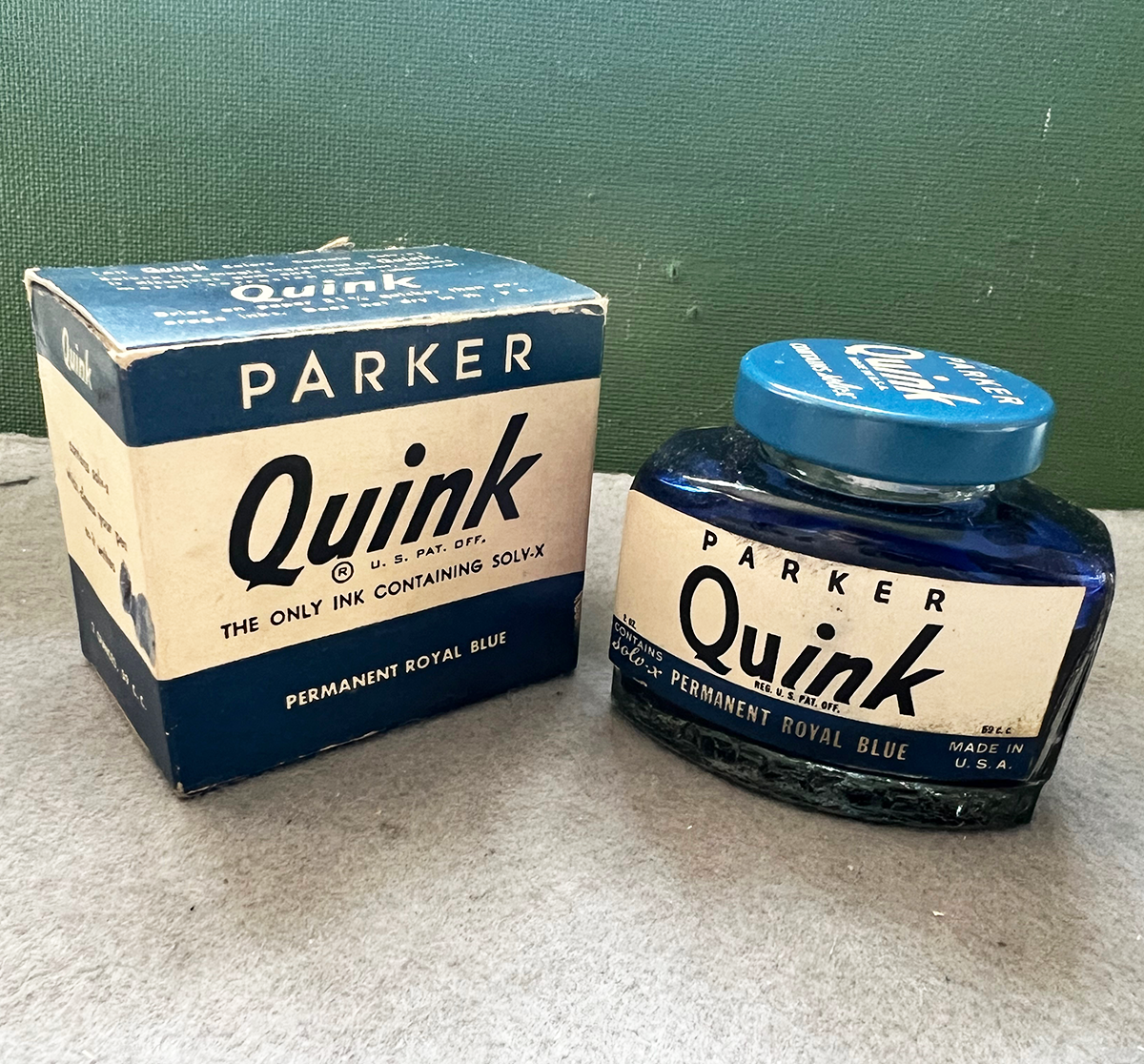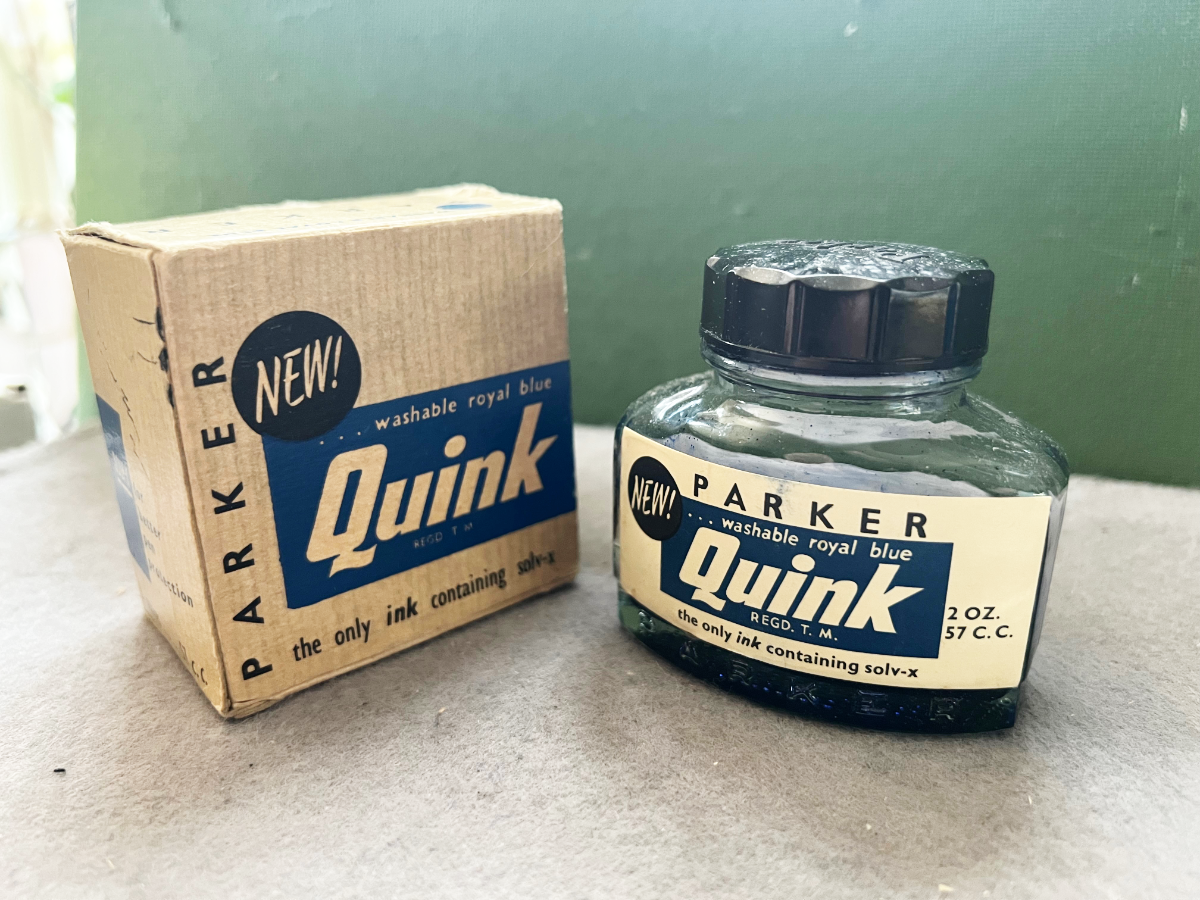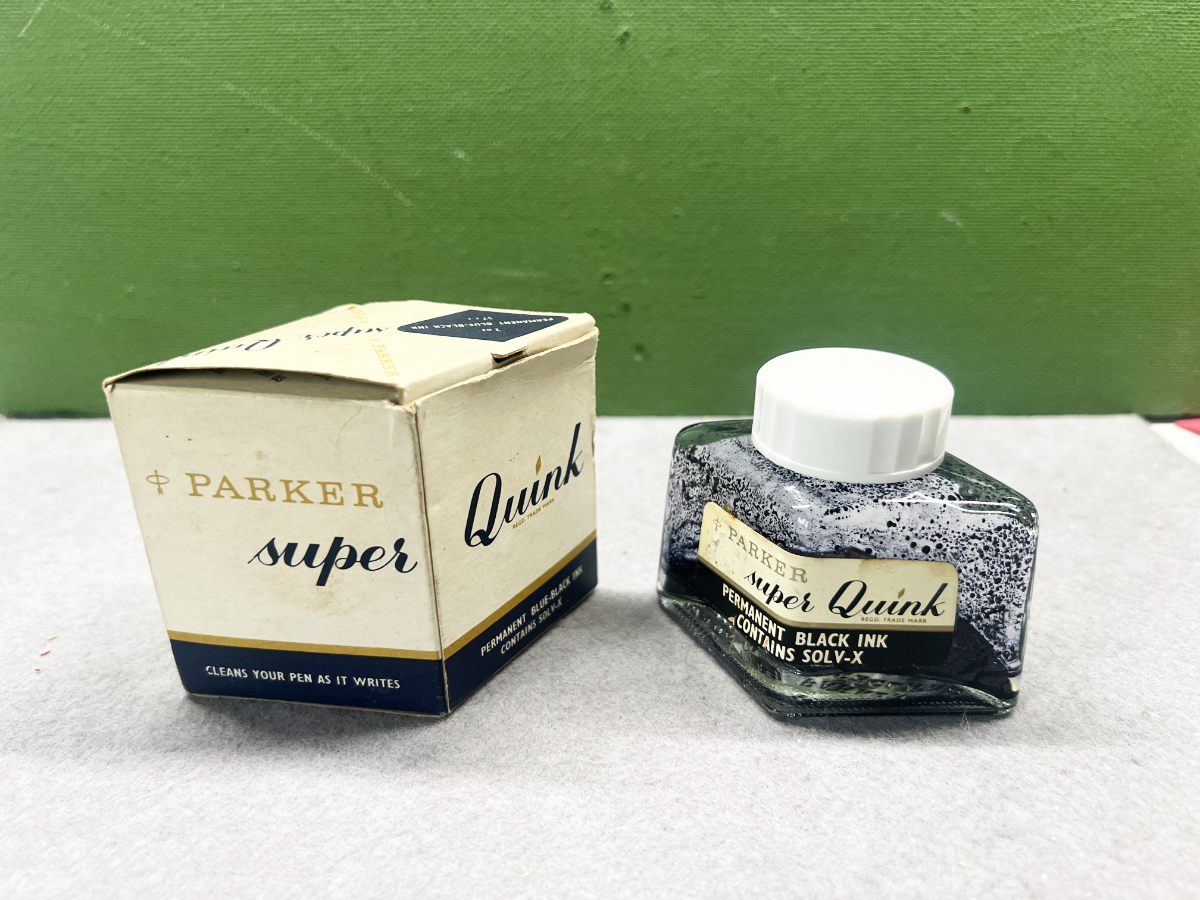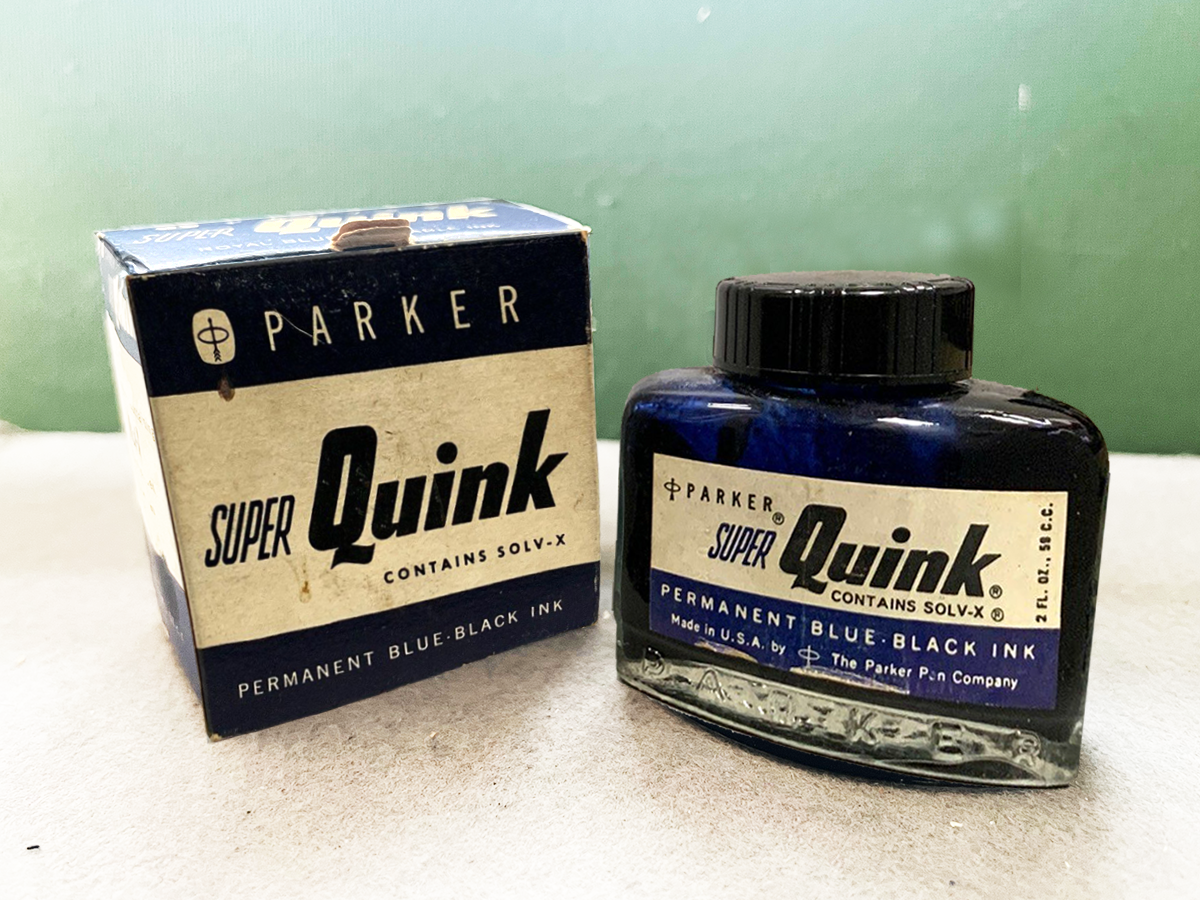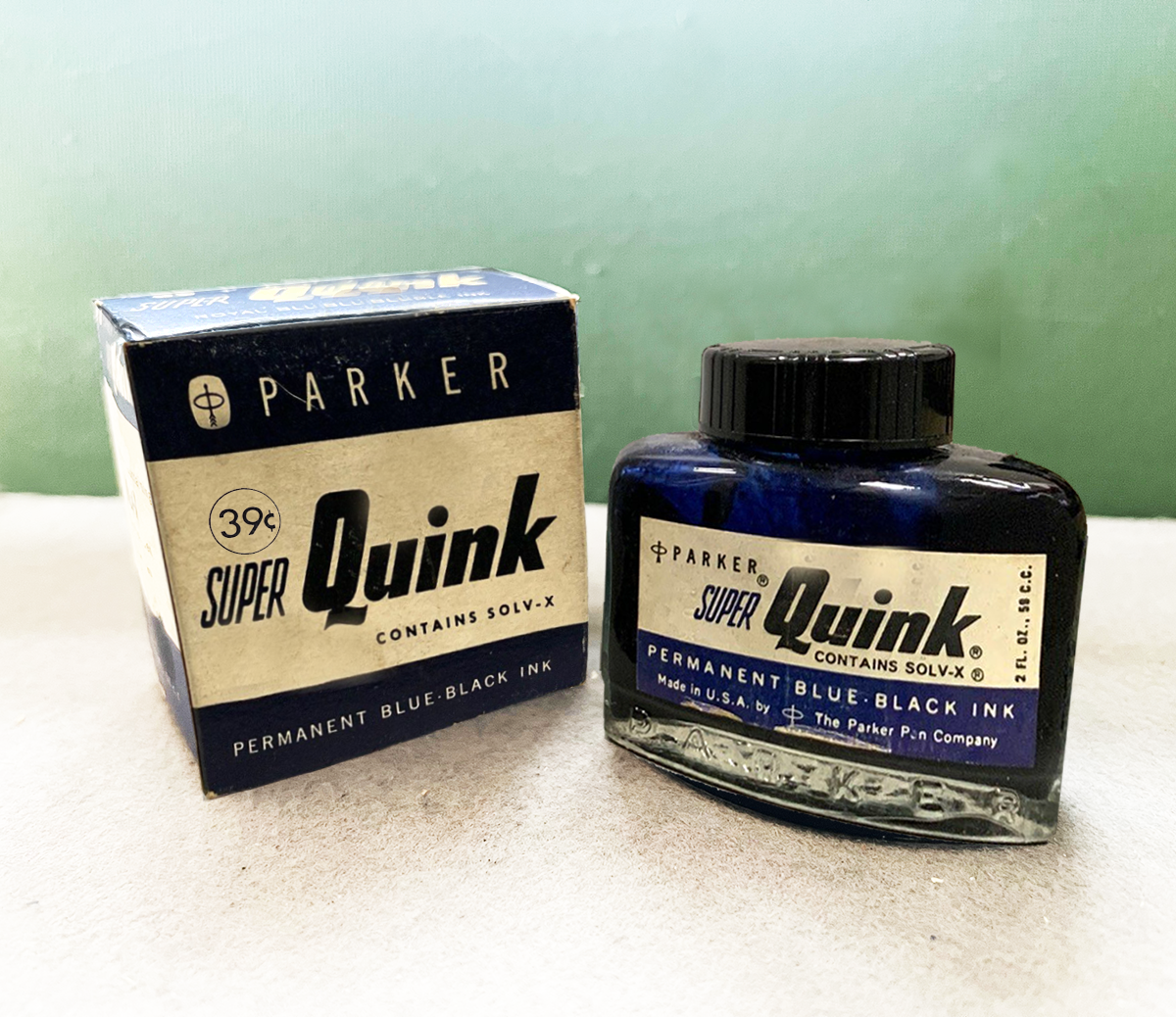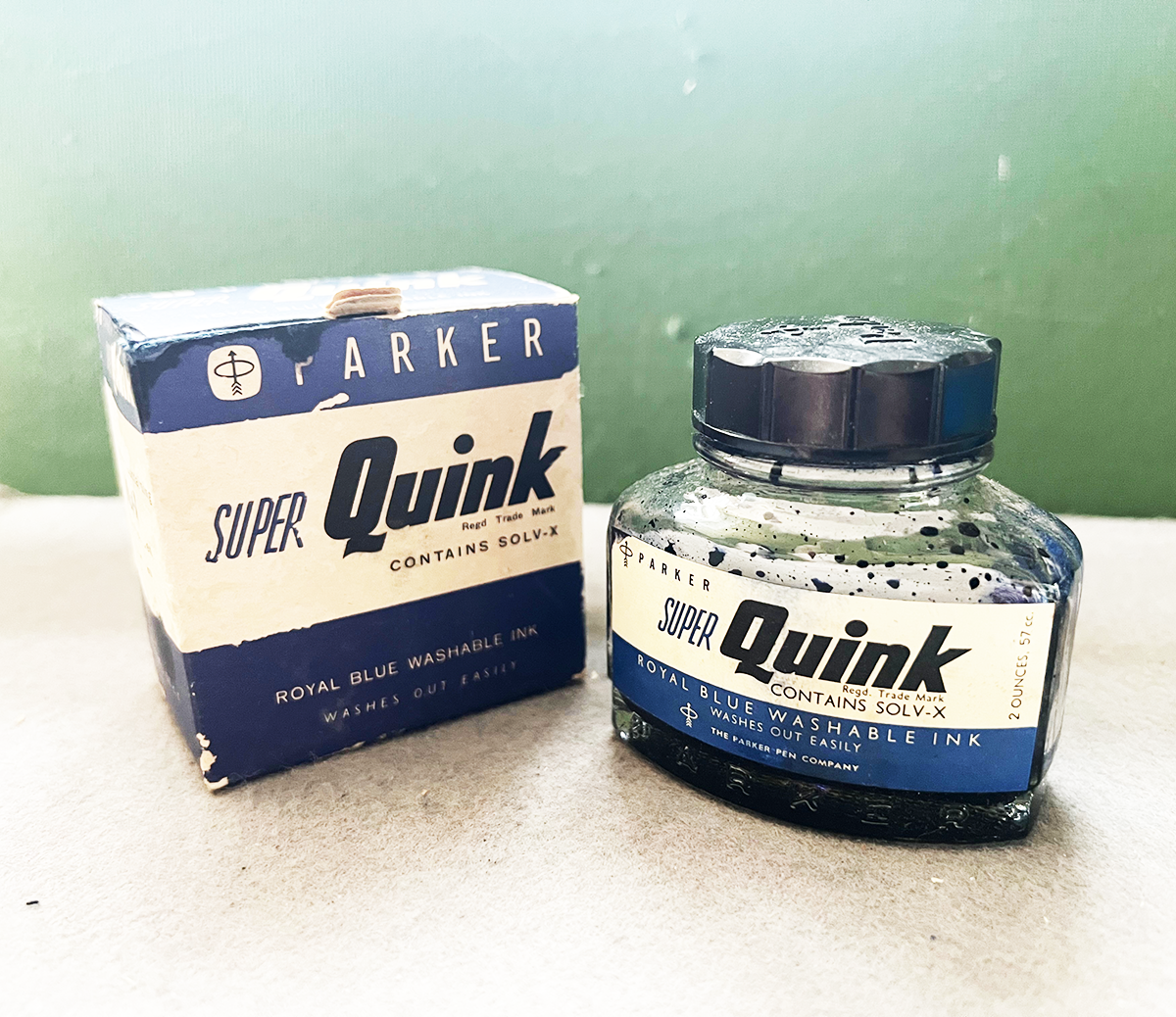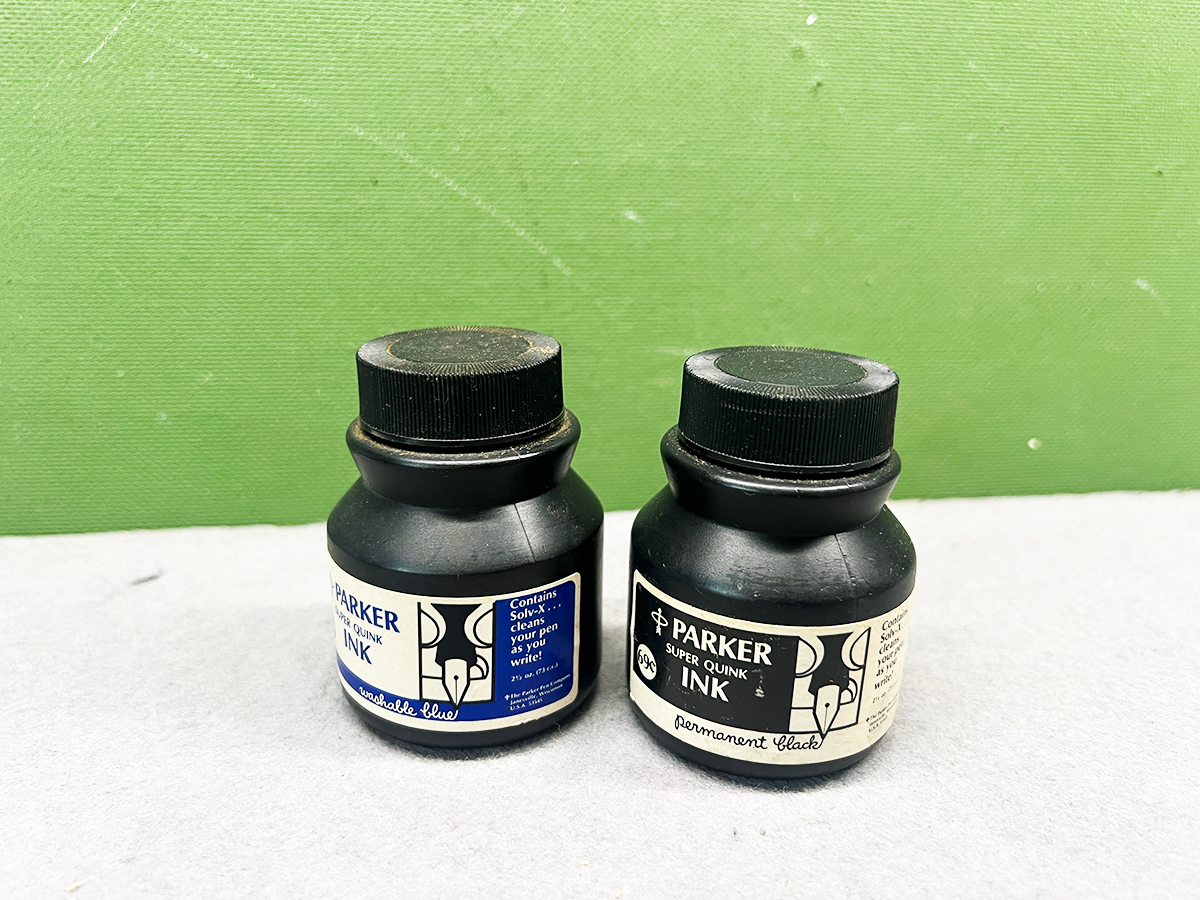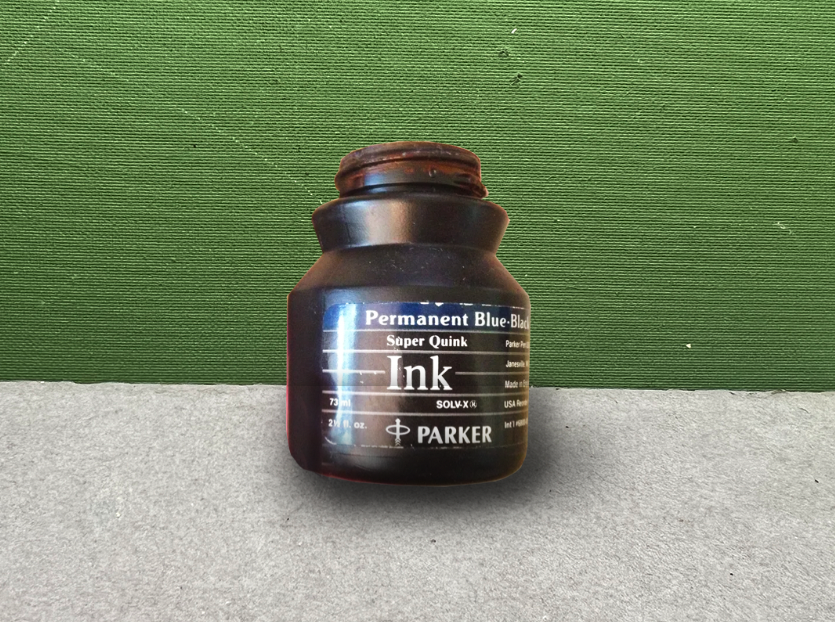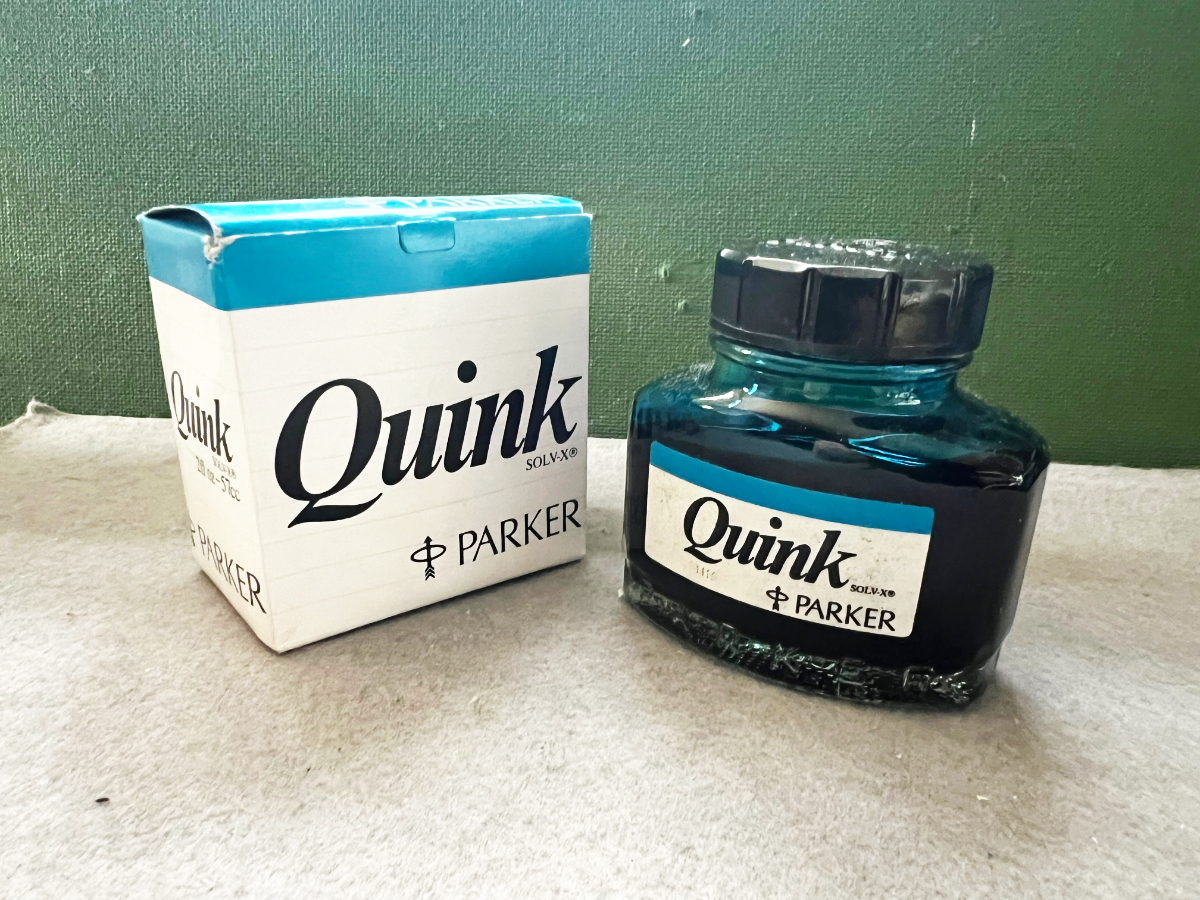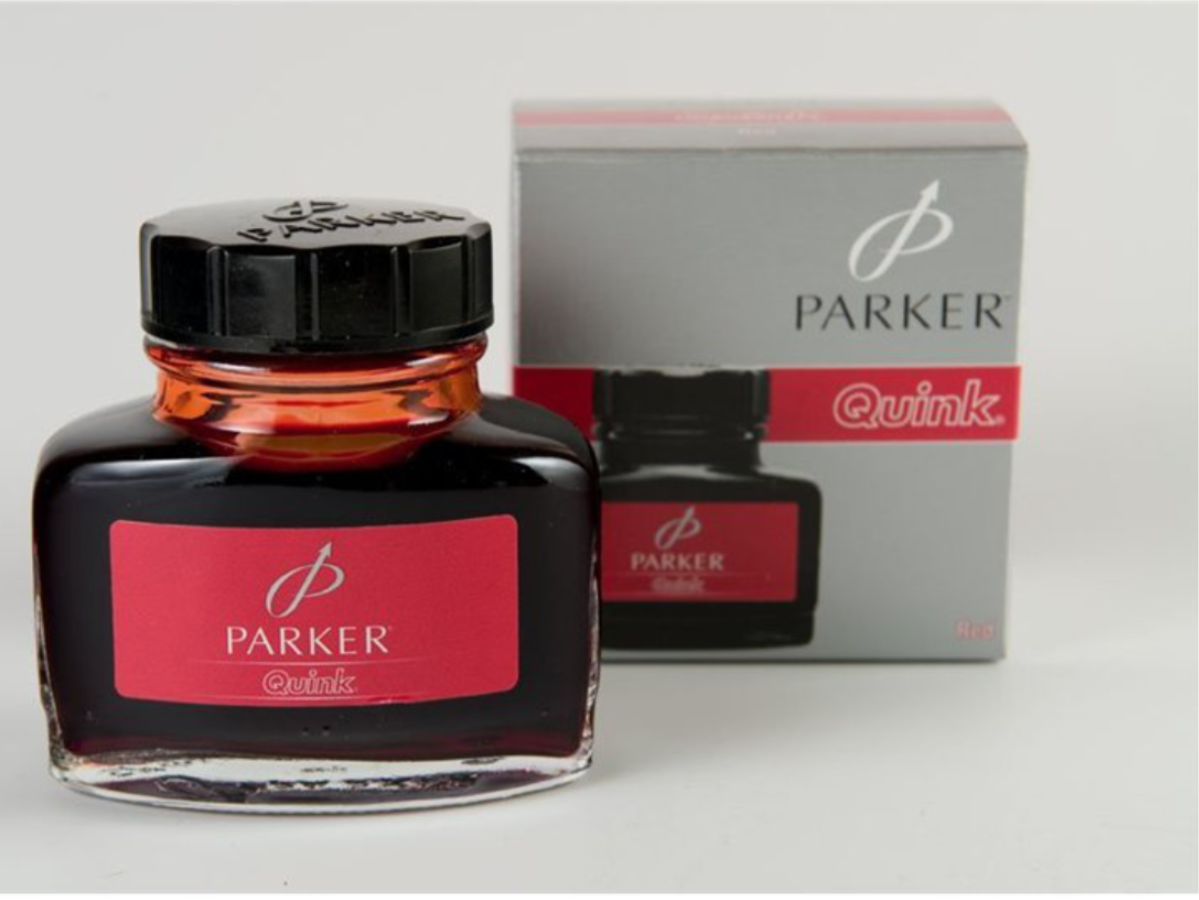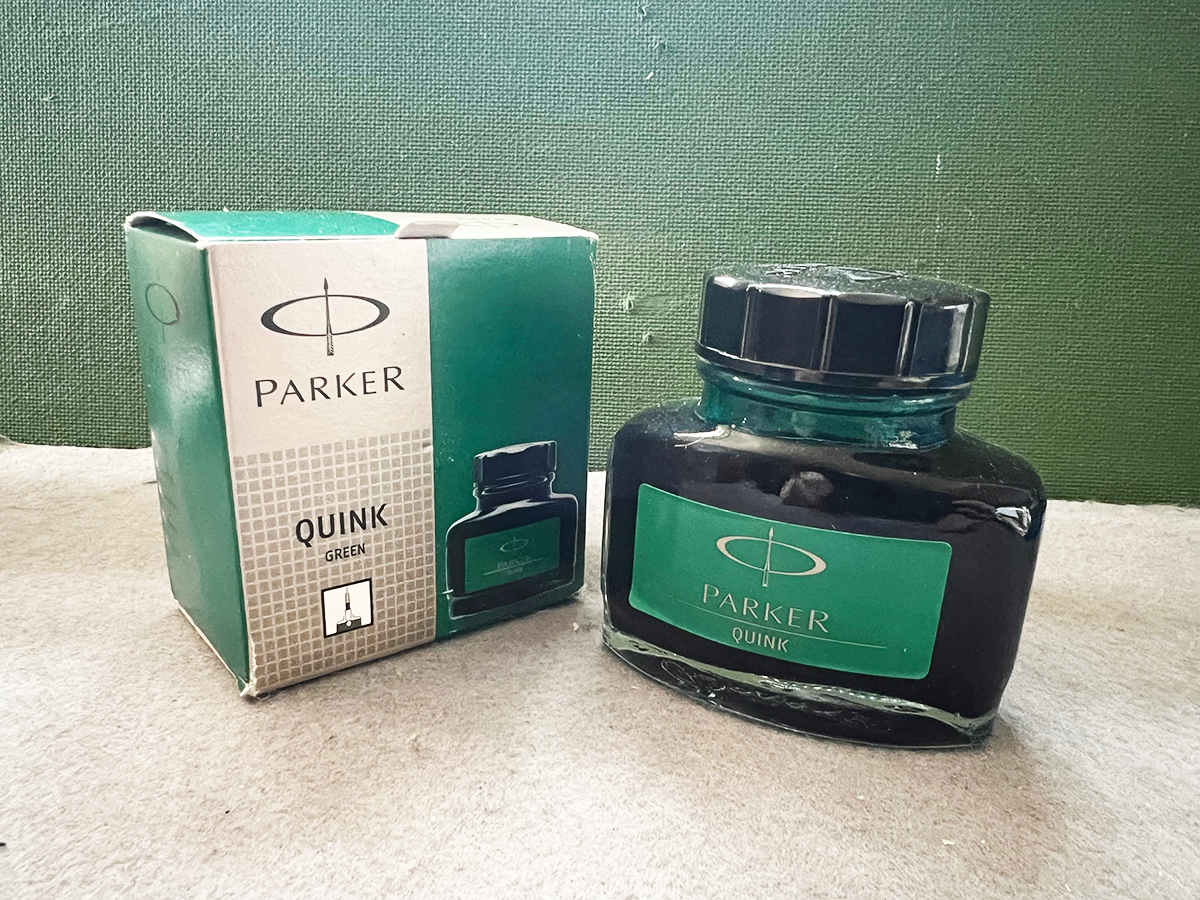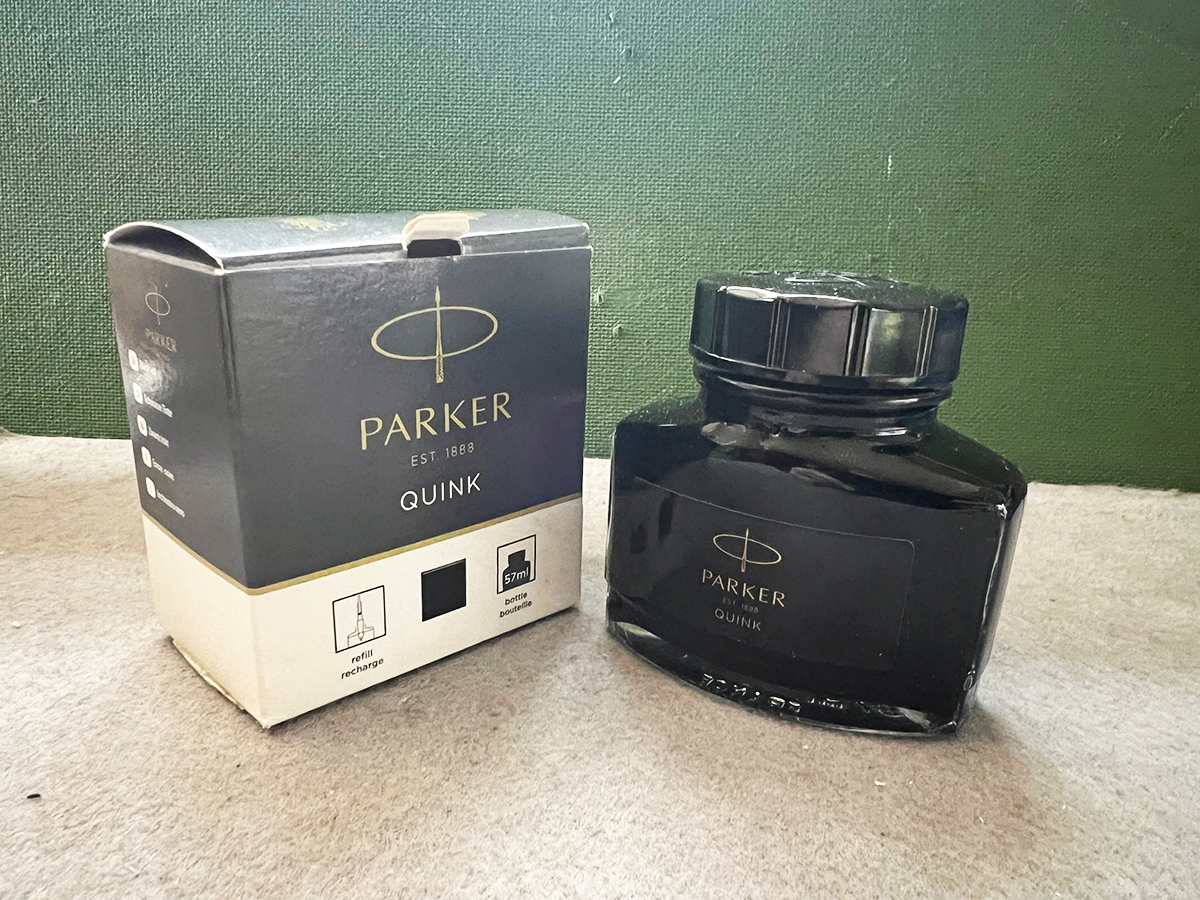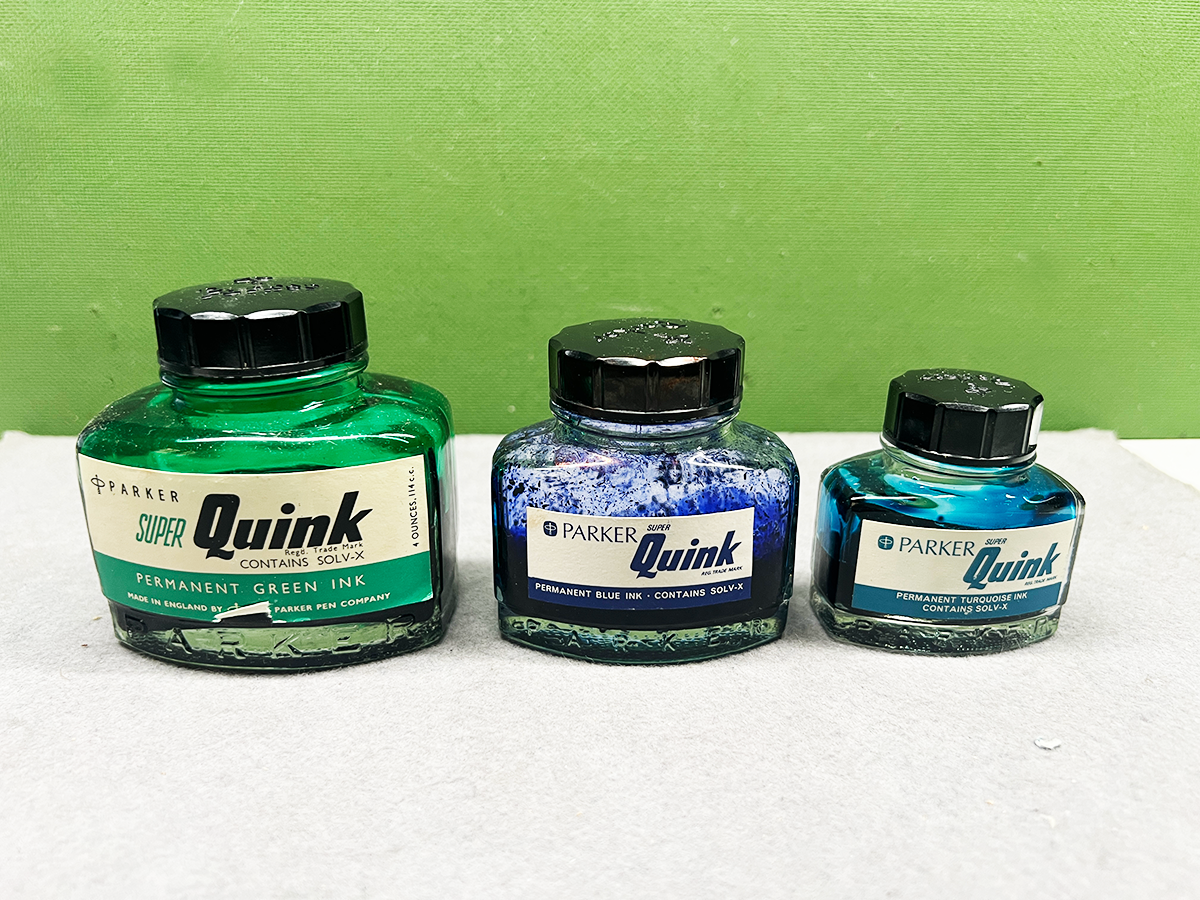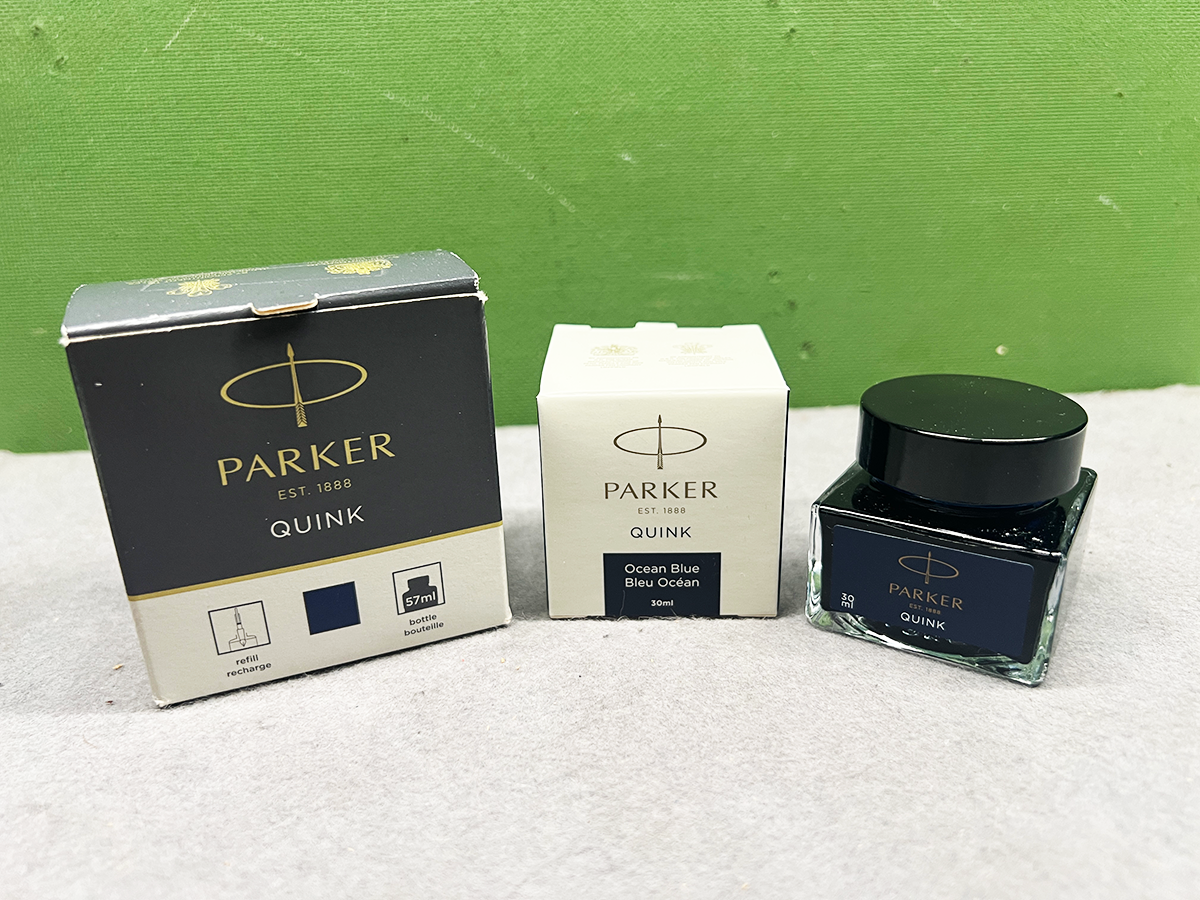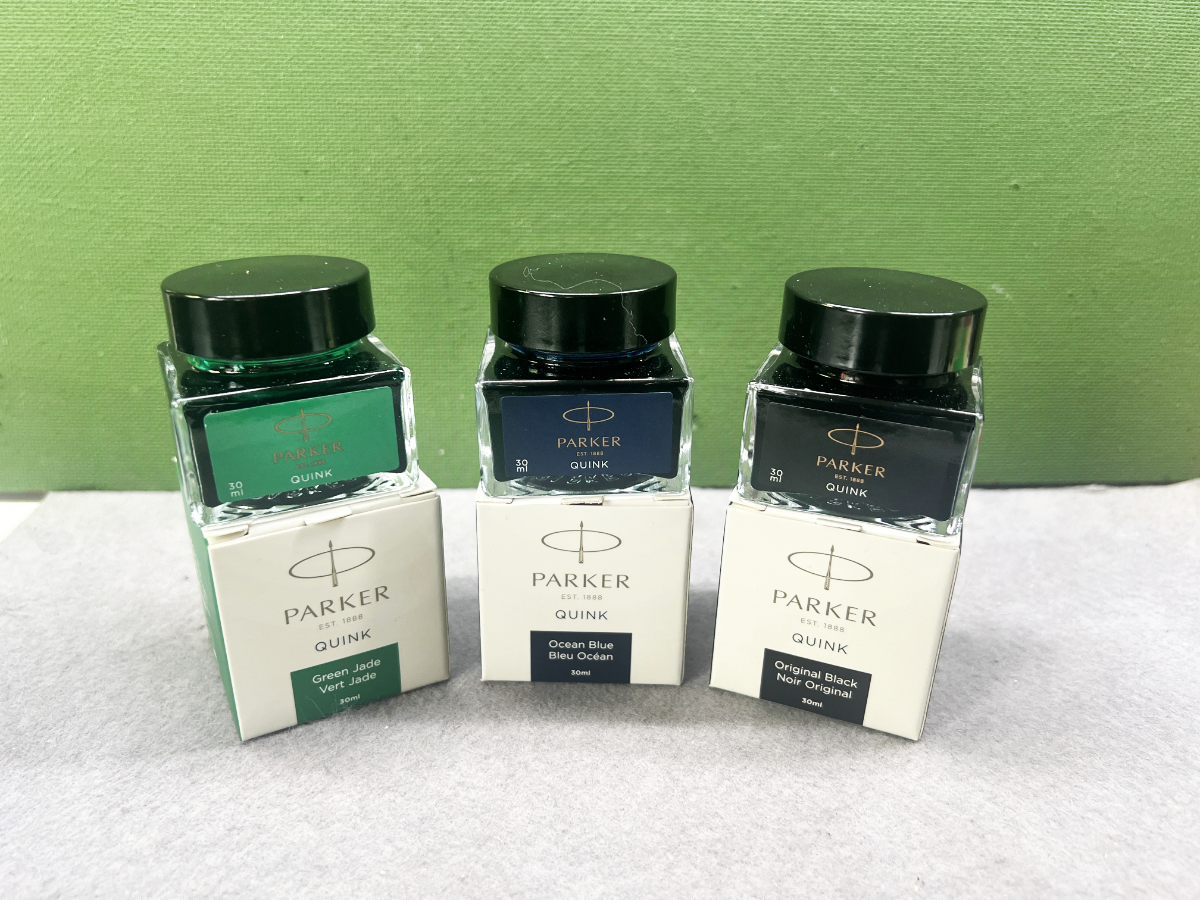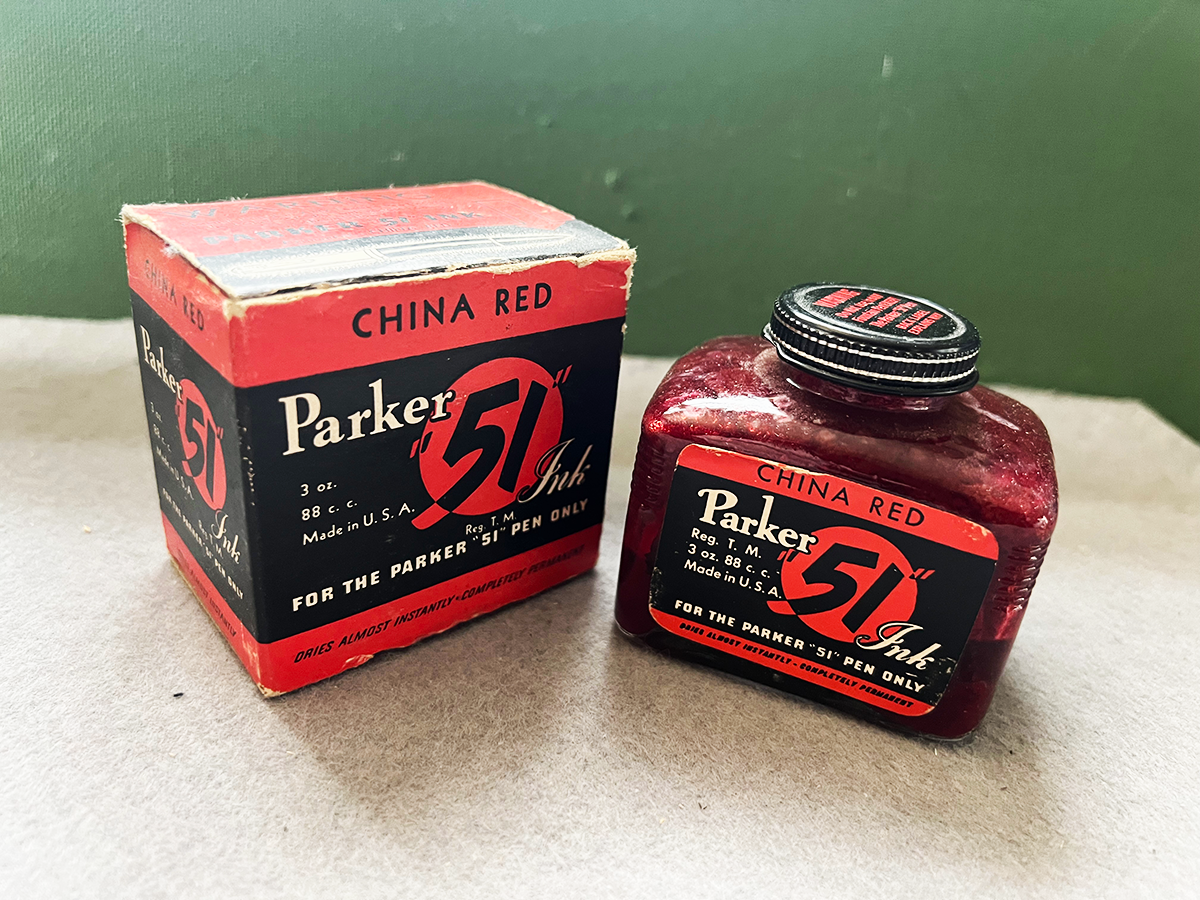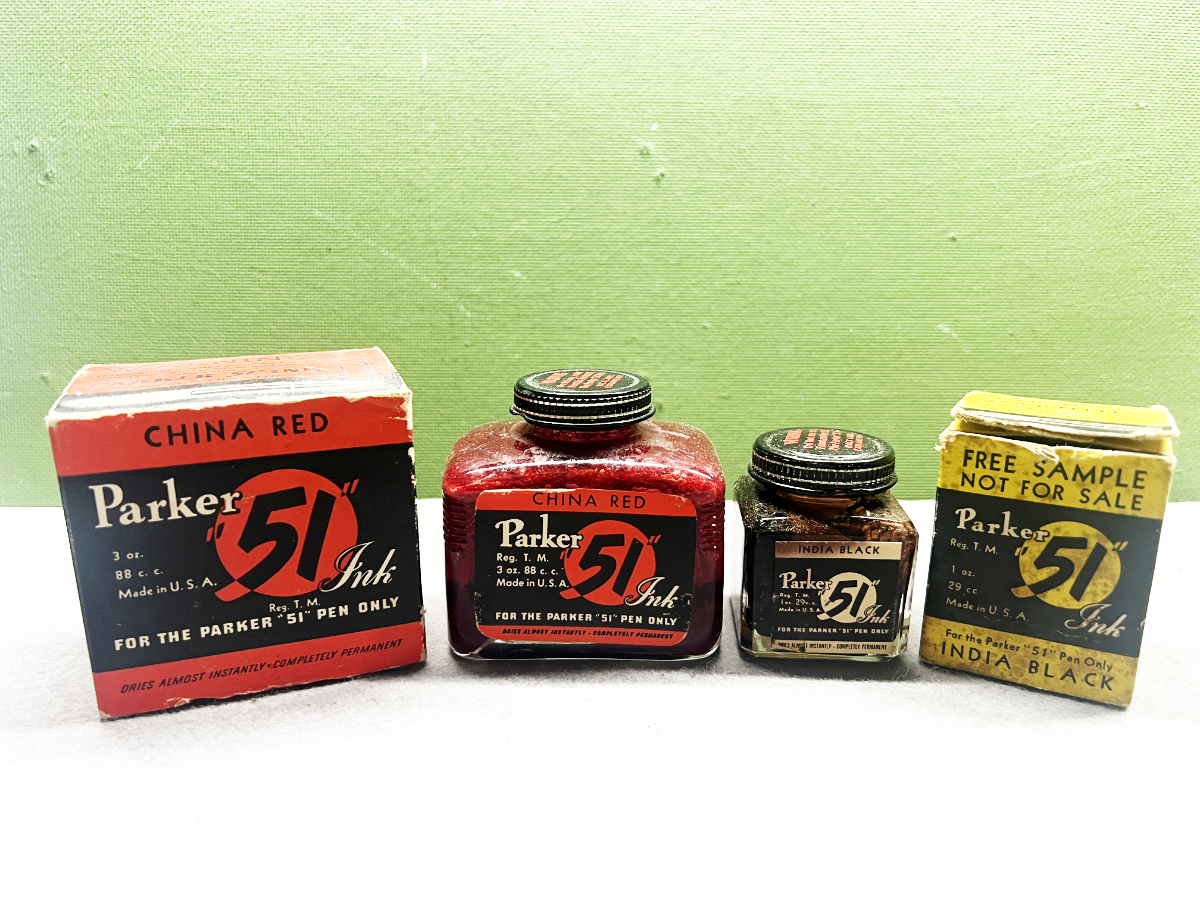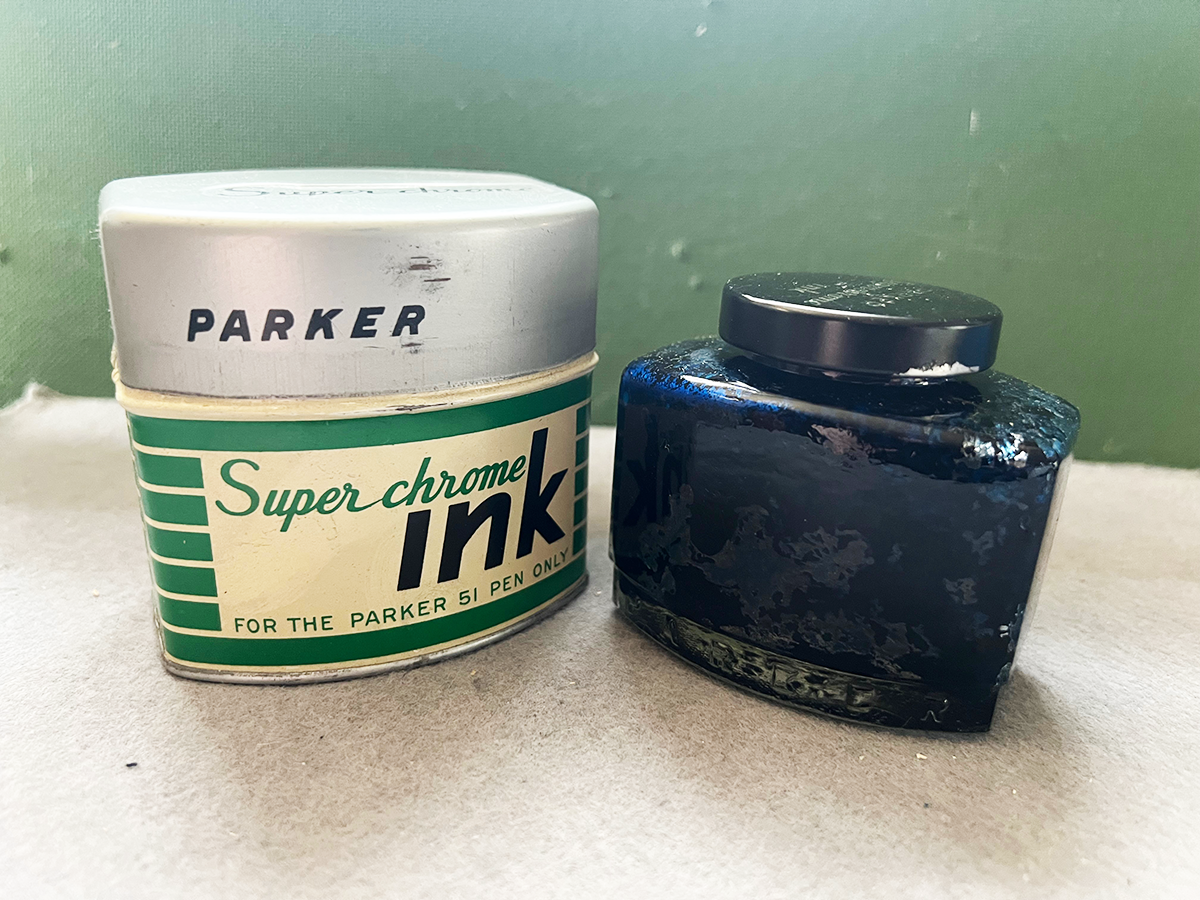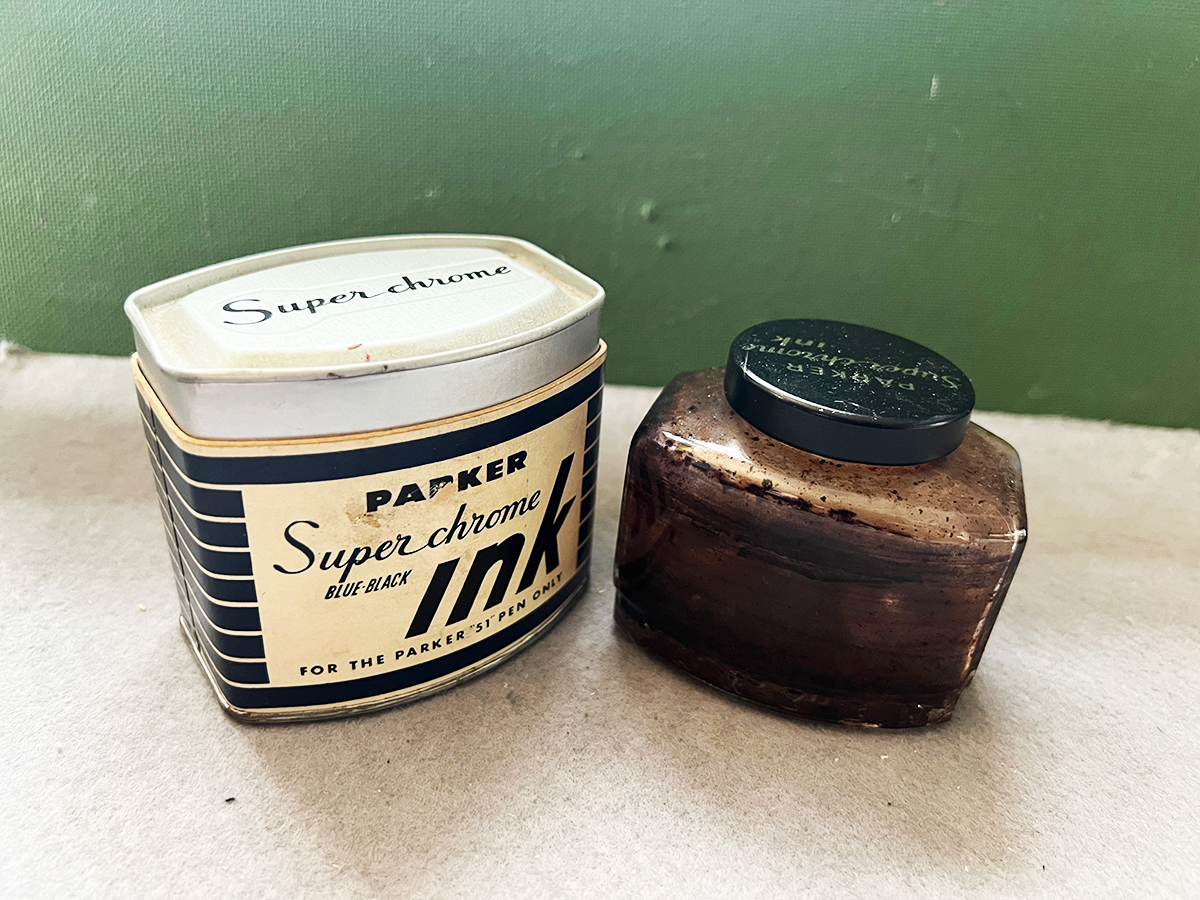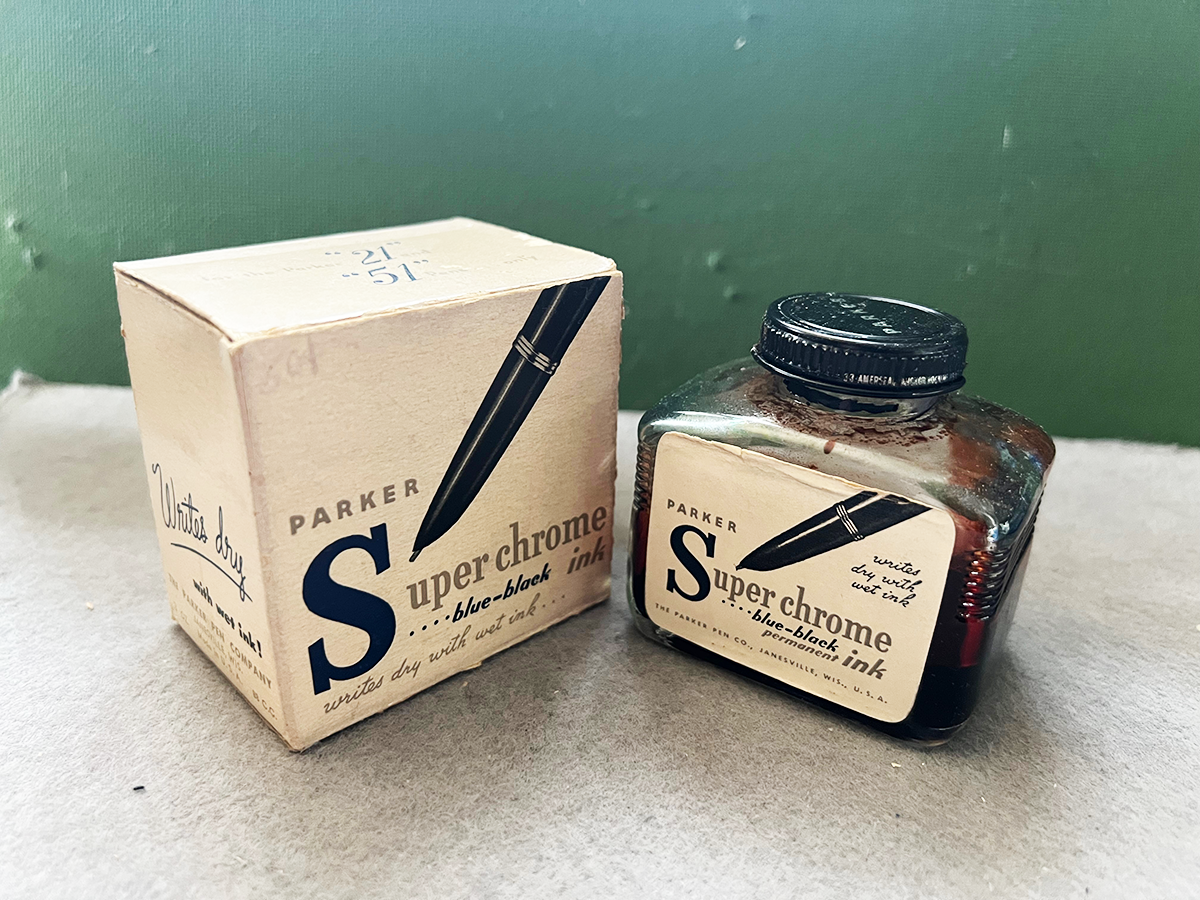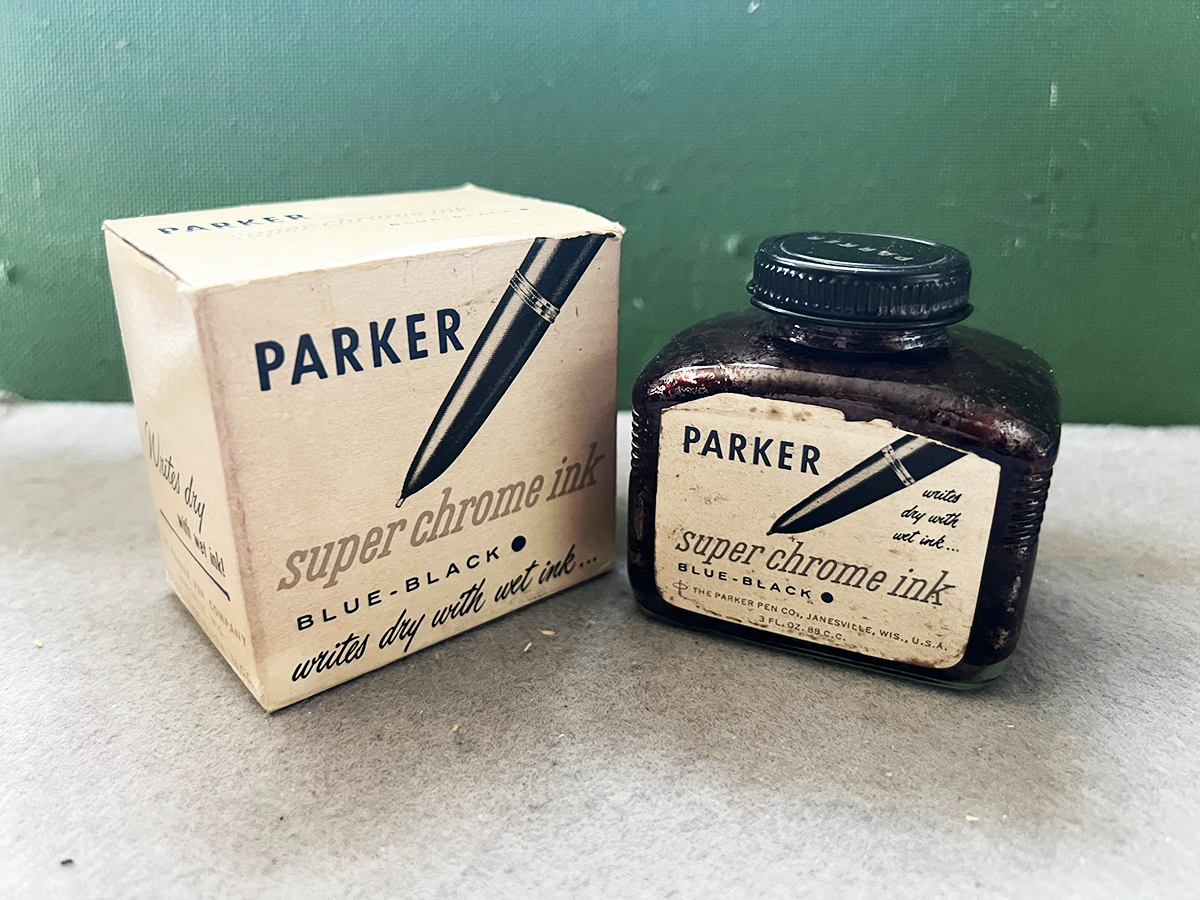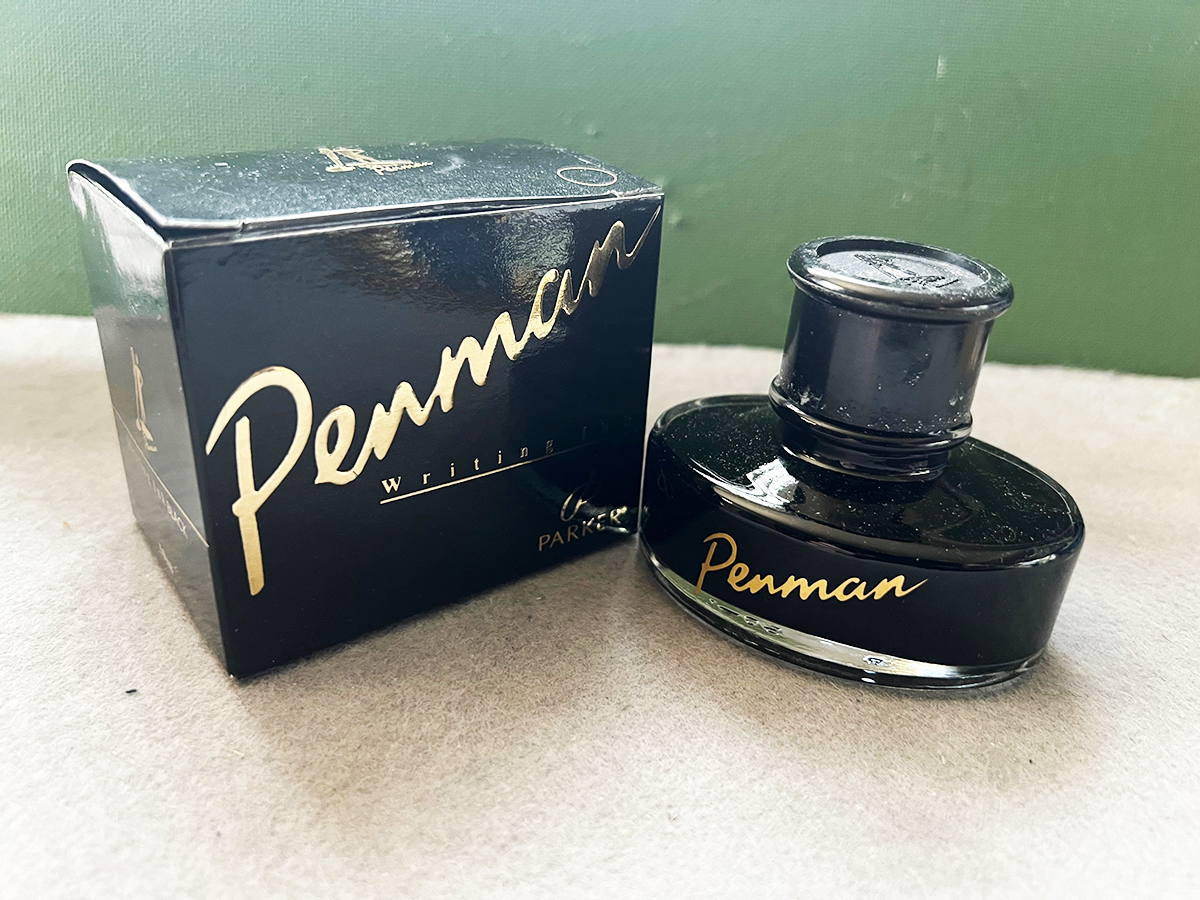Parkercollector.com — Online for 30 years! Click to read:
Parker ink.
1898-current
HISTORY
Collecting ink can be a very fun hobby, since it's still possible to fine nice bottles for reasonable prices. And of course, most vintage ink can still be used, as long as you keep an eye out for mold and stay away from inks made to be used with the Parker "51" only.
Ink in its purest form is really just a liquid containing some sort of coloured sediment and has been used for thousands of years. The first "modern" was used by the Egyptians to write on papyrus and in China it has been around since around 2 000 BC. The first modern like ink was probably made from lamp soot, a technique still used in ink production in China today, and even modern black ink has a base of carbon.
Probably the first in that was produced from a recipe was iron gall ink. It is a black-brown or purple ink made from iron salts and tannic acids, mostly gallotannic acid that came from oak galls (an apple like disease caused by the larva of the gall wasp). After preparation is was often mixed with gum arabic as a binder.
These inks worked well with dip pens, but when fountain pens became common in the 1800s it was soon discovered that these inks weren't suitable since it would clog the ink feed and iron gall ink could also be corrosive. But gall ink is very permanent and used for archival purposes. Although modern versions are less of a hazard to fountain pens it is still recommended that one doesn't leave iron gall ink in the pen for a prolonged time.
George Safford Parker (1863–1937) was an American telegraphy instructor who repaired fountain pens as a side line, and later started making his own. He founded the Parker Pen Company in 1888. The company eventually became one of the first companies in the world to have a global presence.
Pen makers soon realised that dye-based inks were more suitable than pigment based inks. They needed an ink that flowed easily without clogging, wasn't corrosive and were reasonably permanent. There was also a question of shelf life, so eventually biocides was added to the formulas to prevent fungal growth.
Initially Parker bought the ink from an ink producer and put into their own bottles, but later on began to produce their own ink.
Early Parker ink.
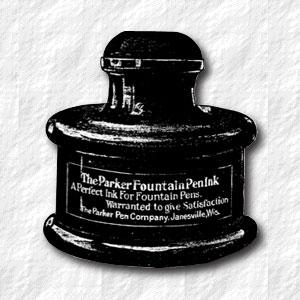
1898—1898
♦ Parker black fountain pen ink.
•4 oz
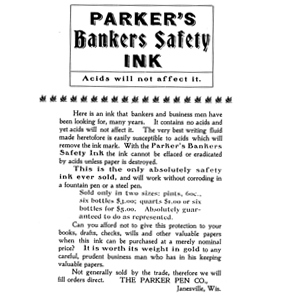
1898—1916
♦ Parker’s Banker’s Safety Ink
• Pint (1898—1899)
• Quart
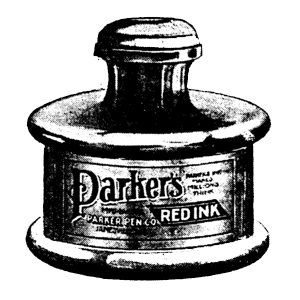
1898—1910
♦ Parker's red Ink
• 1/2 pint bottle
• 4 oz
• 2 oz
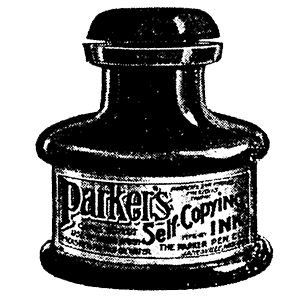
1898—1904
♦ Parker's Self Copying Ink
• 1/2 pint
• 4 oz
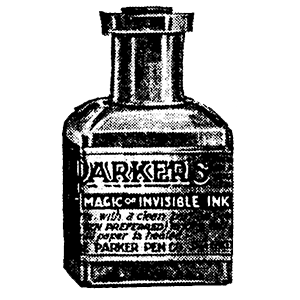
1898—1901
♦ Parker's "magic" invisible ink
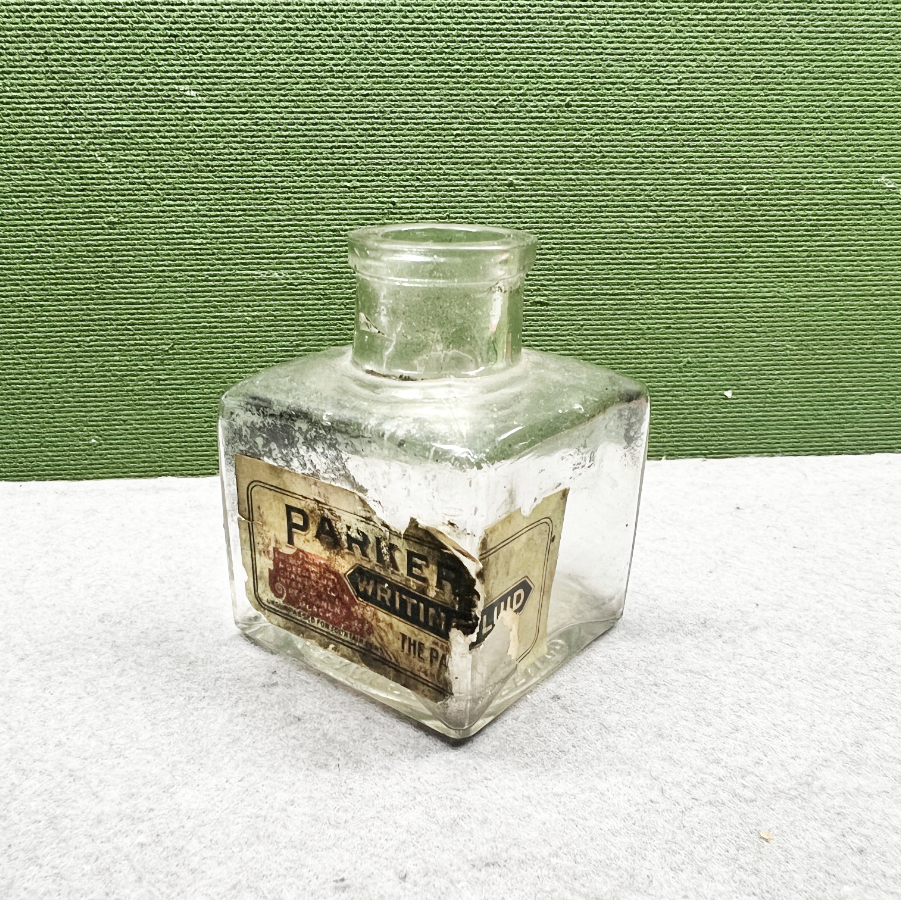
1898—1917
♦ Parker's black writing fluid
• Gallon (School bulk)
• Pint
• 1/2 Pint
• 2 oz
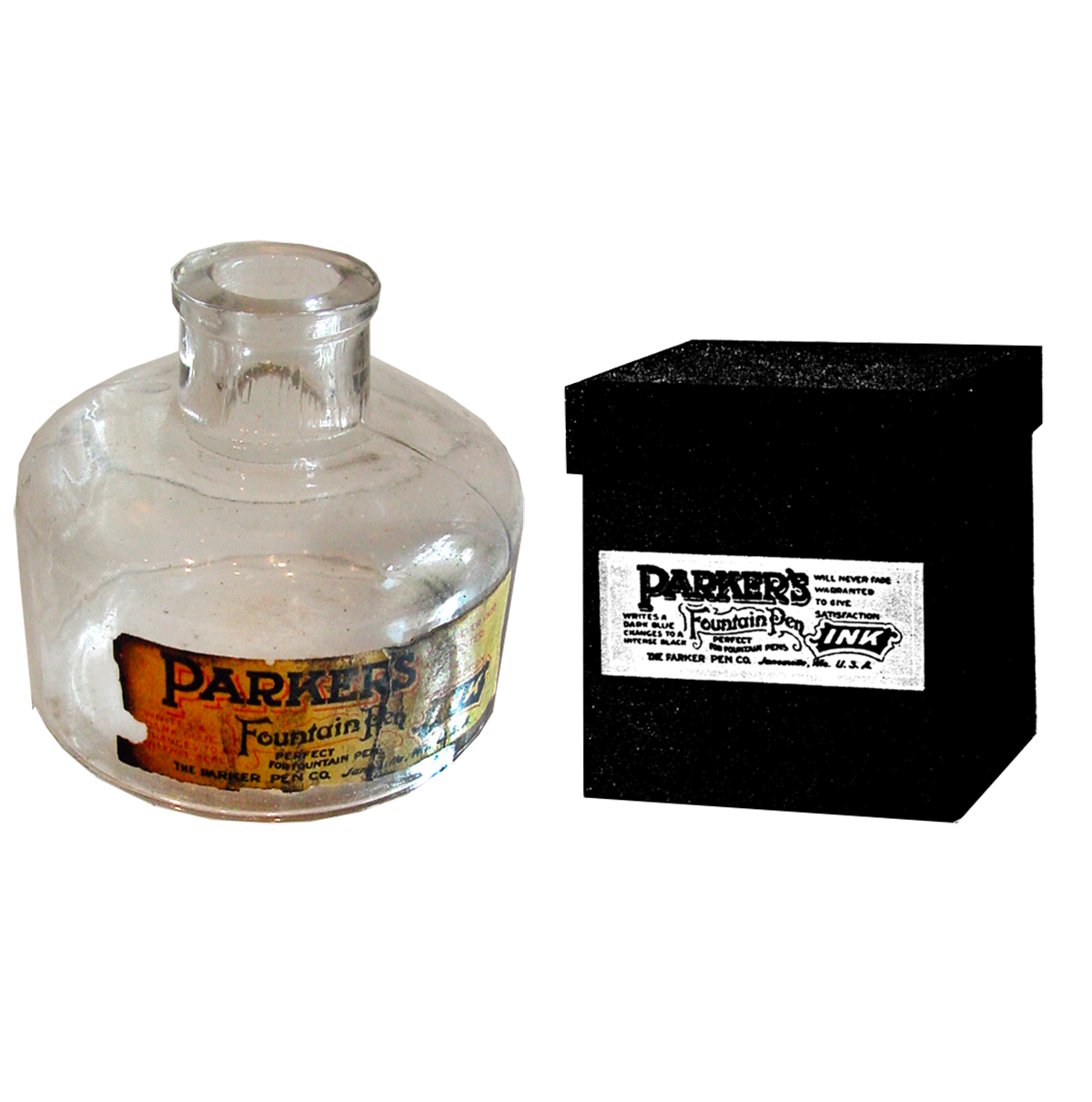
1898—1915
♦
#1 Parker’s fountain pen ink
• Quart
• 4 oz
• 2 oz
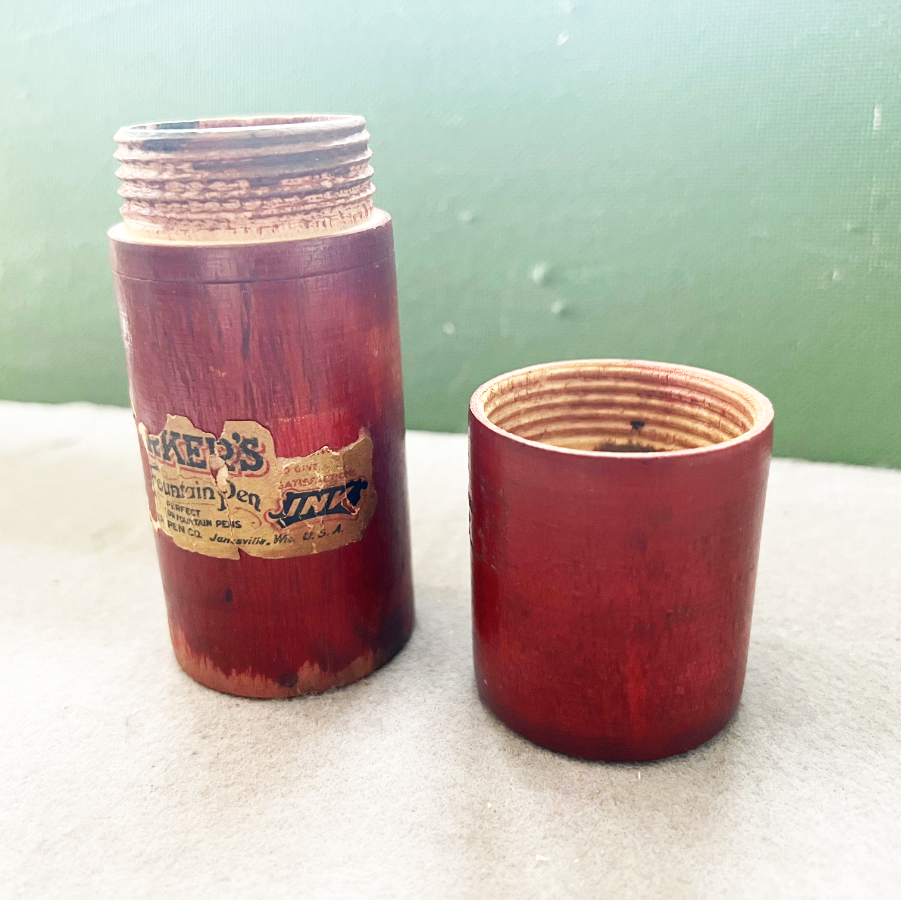
1898—1909
♦ #2 Parker's traveler's ink
• 2 oz
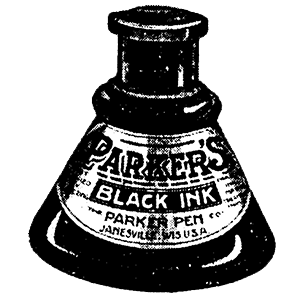
1899—1916
♦ Parker's black (school) ink
• 2 oz
• 4 oz
• Pint (1899-1900)
• Quart (1899-1900)
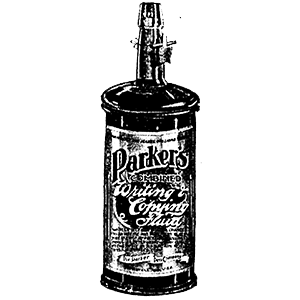
1899—1909
♦ Parker's writing and copying fluid
• Quart
• Pint
• 1/2 pint
• 4 oz
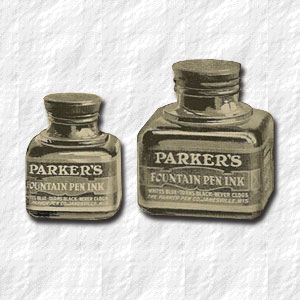
1914—1918
♦ #10 Parker's fountain pen ink
• 2 oz
♦#15 Parker's fountain pen ink
• 4 oz
1918—19xx
Blue-black
Blue
Violet
Green
Red
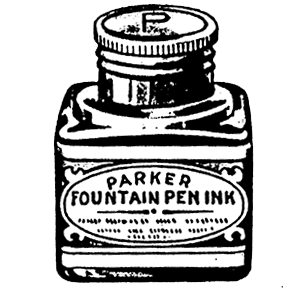
1914—1917
♦ #20 Parker's fountain pen ink
• 4 oz
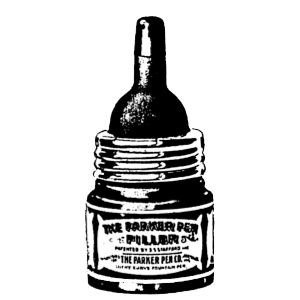
1914—1917
♦ #25 Parker pen filler
♦#35 Parker pen filler
•with a screw top
•traveler's case
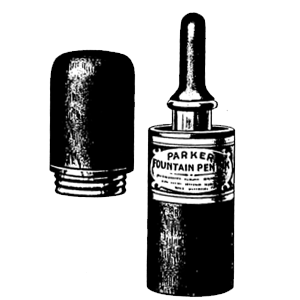
1914—1917
♦#2 Parker's traveler's ink with eyedropper
• 2 oz
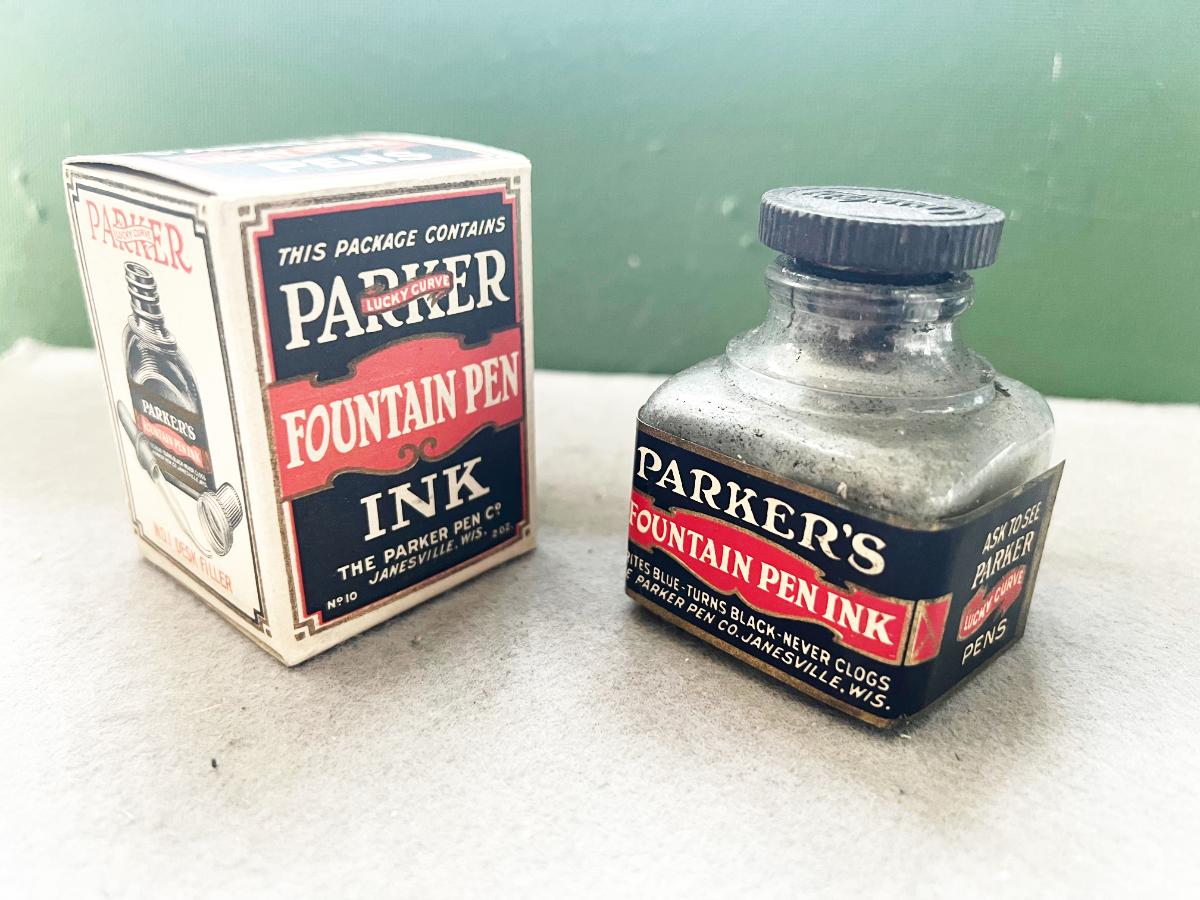
1918—1919
♦#094 Parker's traveler's ink
• 1 oz
♦#20 Parker's Fountain pen ink
• 4 oz
♦#15 Parker's Fountain pen ink
• 3 oz
♦#10 Parker's Fountain pen ink
• 2 oz
♦#01 Parker's Fountain pen ink
• Quart
♦#02 Parker's Fountain pen ink
• Pint
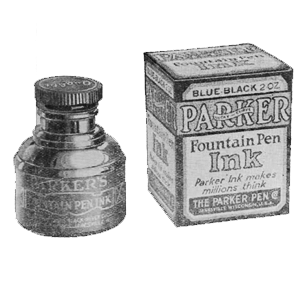
1920—1926
♦#094 Parker's traveler's ink
• 2 oz
♦#20 Parker's Fountain pen ink
• 3 oz
♦#10 Parker's Fountain pen ink
• 2 oz
•Black
•Blue
•Blue-Black
•Green
•Violet
•Red
♦#01 Parker's Fountain pen ink
• Quart
♦#02 Parker's Fountain pen ink
• Half pint
♦#02 Parker's Fountain pen ink
• Pint
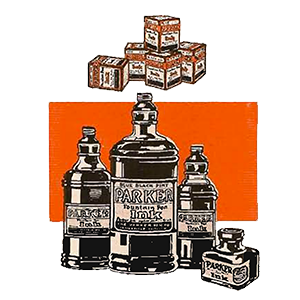
1927
♦Parker's Fountain pen ink
• 2 oz
•Black
•Blue
•Blue-Black
•Green
•Violet
•Red
• Quart
• Half pint
• Pint
♦#094 Parker's traveler's ink
• 2 oz
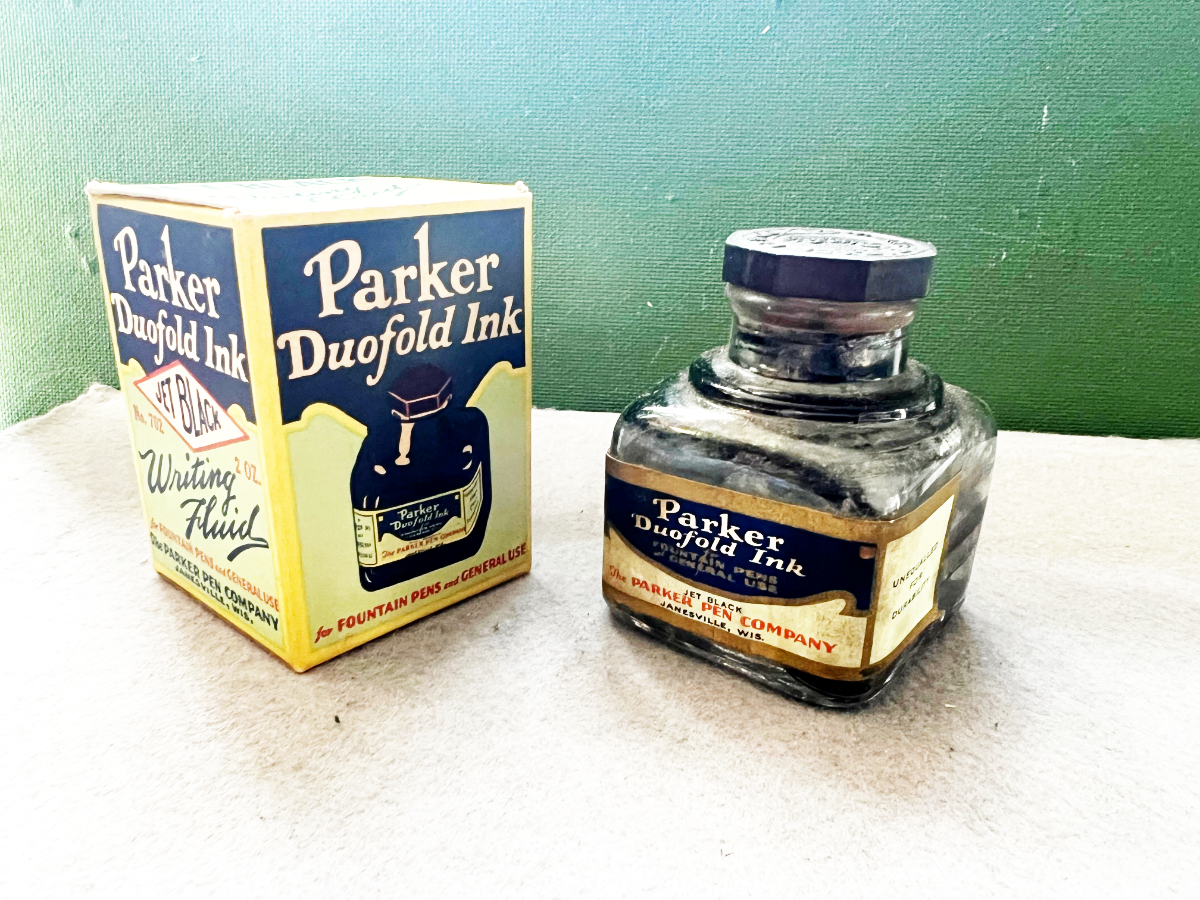
1927-1930
♦Duofold, USA
same ink, new box and branding.
• 2 oz
•Black
•Red
•Blue black
•Green
•Violet
•Blue
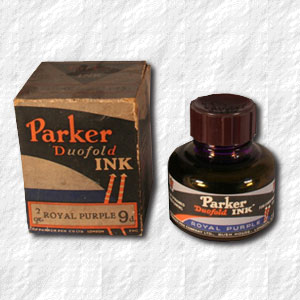
1927—1929
♦Duofold, England
• Intense scarlet
• Blue black permanent
• Royal purple
• Emerald green
• Jet black documentary
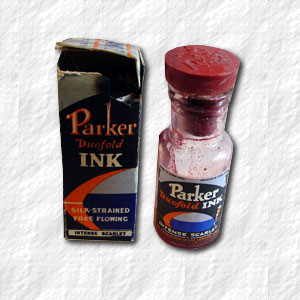
1927—1929
♦Duofold, England
Sample bottle
• Intense scarlet
• Blue black permanent
• Royal purple
• Emerald green
• Jet black documentary
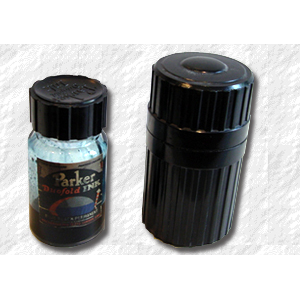
1927—1929
♦Duofold, England
Traveler's bottle
• Intense scarlet
• Blue black permanent
• Royal purple
• Emerald green
• Jet black documentary
Parker Quink.
The story is that Kenneth Parker, son of the founder, was dissatisfied with the low quality of ink and decided to find a better solution, having Parker manufacturing its own. Evidently almost 70% of the problems with pens sent to the repair department had to do with the use of bad ink. He hired two chemical engineers at the Miner Laboratories of Chicago to do the research, specifically finding a way to produce an ink that stayed wet on the metal nib, but dried instantly. One of the lead chemists was Carl S. Miner. The other one, Galen Sayler, was eventually hired in 1929 by Kenneth to continue the research, and he was set up in a laboratory in Janesville.
It took him and his collegues three years and 1021 formulas until they found the secret formulation in number 1022. The ink, called Quink, a contraction of "quick drying ink", was advertised as drying 31% faster on paper than average inks, with a deep and brilliant colour. Quink has a surface tenson of 55 dynes per centimeter (destilled water has about 72).
The following is a probable composition of black Parker Quink, based on microanalyses made by the Northern Arizona University regarding the inks chemical composition:
• 48% Carbon in the elementary state
• 23% Bituminous or resinous organic compounds with high carbon content
• 16% Sodium sulfate
• 7% Calcium sulfate
• 4% Potassium sulfate
• 1% Iron(II) sulfate
• 1% Mineral species (not characterized) containing Nickel, Cromium, Copper, and Zinc.
The low ferrous sulfate content in Quink makes it less susceptible to deterioration. (
Miguel Jose Yacaman et al)
It has been suggested that Quink contains isopropyl alcohol, it does not. This might be a confusion caused by the later trade names "Super Quink" and "Superchrome", the latter did contain isopropyl alcohol. Modern Quink does however contain monopropylene glycol, which is also an alcohol. But while isopropyl alcohol has solvent properties and can damage both plastics and especially celluloid, causing softening, warping, swelling, clouding, brittleness or even dissolve it, monopropylene glycol is mild and compatible with most plastics including celluloid, posing minimal risk of damage. It maintains moisture, controlls viscosity, functions as a stabiliser, and prevents premature drying. It is mostly non-toxic and biodegradable.
The research for Parker's ink Quink had a production cost of $68 000, which is equivalent to about $1.5 million in purchasing power today. For a product that keeps going stong almost a hundred years later, one might argue that it was a good investment.
The patent was filed December 26, 1930, registered April 21, 1931, and interestingly enough it states that the brand name "Quink" was first used on December 1, 1929, while Parker normally states that the ink was first offered in 1931. It might of course have been used in marketing before that, building the brand in anticipation of the launch.
Disclaimer: It is very hard to pinpoint a specific date when a product was offered för sale. Also two boxes with different design that were sold simultaneously isn't unheard of. Collector's really like to know dates exactly, but unless there's an actual date code, we have to rely on guesswork, based on old pamphlets, ads and other records.
1931-1934♦ Parker Quink.This box first appeared in a 1931 Parkergram (a Parker in-house newsletter) and also in 1934. It contained a newly designed bottle, often referred to as the "umbrella" bottle by collectors. The bottle was designed by the known glass artist Fuerst, and and the box was designed by the frenchman Simon de Vaulchier.
•2 oz
•4 oz (depicted)
•Half Pint
•Pint
•Quart
•Gallon Jugs
•5 Gallon Keg
•Permanent Blue black
•Permanent Red
•Permanent Green
•Permanent Violet
•Permanent Black
•Washable Blue
1934-1938
♦ Parker Quink. This box with the "umbrella" bottle first appeared in Parker Catalogues 1934 through 1938.Later bottles have a white label with horizontal strips. Depicted in a Canadian made bottle sold in th UK, note the slightly different design.
•2 oz
•4 oz (depicted)
•Half Pint
•Pint
•Quart
•Permanent Royal Blue
•Permanent Blue black
•Permanent Black
•Permanent Red
•Permanent Green
•Permanent Violet
•Permanent Brown (intro 1937)
•Washable Blue
•Washable Black
In June 1934 Parker and Quink were featured in a 16-page insert in The Saturday Evening Post covering Parker's business around the globe, showing off pens (especially the new Vacumatic) and display cases. It also featured an article by George S Parker regarding his travels among the South Sea islands. And an overview of the national Quink ad campain in 19 magazines, 64 Sunday newspapers, "numerous" college papers, in which Parker hoped to reach 32 million families for several months.
Several cartoons were made for the nationwide Quink ad campaign of 1934.
1939-1941
♦ Parker Quink. In 1939 the newly designed bottles, often referred to as the "art deco" was introduced. It was patented in 1938 by Parker's Ivan Tefft (who also had a hand in designing maybe the most distinctive Parker attribute, the arrow clip). Also Trace Christenson and Warner Hoople are mentioned. The design of the boxes stayed the same, but there are examples where the top and bottom are in black with white text.
•It came in the standard 5 sizes and 9 colours.
1942
♦ Parker Quink. 1942 saw a few changes of the boxes. Surprisingly enough the "umbrella" bottle made a short return, perhaps this was a wartime decision. It is clear that Parker at this point were cleaning out their store rooms and using up old stock. Many Vacumatic pen anomalies have been found from this period. The box is the first one mentioning the new formula SOLV-X, which were supposed to "clean your pen as it write". According to the filings the SOLV-X trademark was first in use July 11, 1942.
•It probably came in the standard 5 sizes and 9 colours, but there's no further information on the box.
1942
♦ Parker Quink. Also in 1942 Parker launched the first of the famous blue-boxes. They contained the "art deco" bottles, but differed from the subsequent boxes in that they were blue at the top and had a wide white band at the bottom. Also one of the tabs had an ad for the Vacumatic pen, and on the bottle label under "Quink" it said "Reg T.M.".
•It came in the standard 5 sizes and 9 colours.
1942-45♦ Parker Quink. Microfilm black for V-mail. During World War II the Allies wanted to reduce the cost of carrying mail to and from soldiers in Europe. They came up with the idea to photograph the mail with microfilm after being censored. The film would then be shipped to its destination and then printed back to paper, reducing 37 mail sacks to a single one. It also removed the possibility of secret communication, since invisible ink would not photograph. There was some problem with weak ink, so Parker launched an extra black ink that would photograph well.
It was first advertised in 1942 and was phased out in 1945. The box was very patriotically made in red, white and blue.
•It was offered in the standard 5 bottle sizes.
David R Cress, who worked for Parker for many years remembers in his "The Parker Pen Co. Technical Division": "One of the stories I remember was that uneducated pregnant women in Africa or Asia would drink Parker fountain pen ink so that their children would be literate. This is definitely not recommended, but Parker inks were all tested and were not toxic. Independent test laboratories used a 'rat' test. Large quantities of ink was force fed to a number of rats; if any would die, that formula was not used."
David R. Cress worked for 20 years at the Parker Technical Division and was involved in many projects. He was involved in devising processes like injection molding, screen printing, sputtering, decorative hot stamping and powder coating, and was also involved in the developement of the Systemark, among many other things.
1943-1947♦ Parker Quink. In late 1942 or early 1943 the design of the box was changed again. It was still blue and white, but now the lower part was also blue. Within a year or so there was also a change in the text "Contains pen-protecting solv-x", omitting the word "Which". In 1943 the Vacumatic ad on the tab disappeared, most likely because the new Parker "51" was heavily advertised. On the bottle the words "The only ink containing pen-protecting Solv-x" under the "Reg T.M." was now found.
•The bottle sizes stayed the same but there was a change in the ink line-up:
•Permanent Black
•Permanent Blue Black
•Permanent Royal Blue
•Permanent Red
•Washable Black
•Washable Blue
•Washable Brown
•Washable Green
•Washable Violet
1947-1948
♦ Parker Quink. In 1947 Parker redesigned the boxes again. The font remained albeit a tad thinner, but the box now came in the colour of the ink, and read "Contains SOLV-X which cleans your pen as it writes" on the side. On the inside tab there was a four-point information on how SOLV-X cleaned the pen:
•1. Prevents gumming and clogging
•2. Prevents metal corrosion, rubber rot
•3. Dissolves, flushes away sediment
•4. Cleans your pen as it writes
The "art deco" bottle stayed the same.
•It came in the previous 5 sizes and 9 colours.
The Parker ink factory in Dover, UK, in the 1960's. (Picture by Malcolm Troak)
Until World War II, all pens sold by the English company were manufactured by Parker in Canada, but wartime trade restrictions forced an establishment of manufacturing facilities at Newhaven. Later, another plant was set up beneath the white chalk cliffs of Dover. By the late 1950's the Dover plant was manufacturing 14 million ink bottles annually while the Newhaven factory were producing Parker 61's, 51's and the UK version of Duofolds, as well as ballpoints for the two latter.
The Dover factory in time served most of Europe with Parker ink and gradually took over the production from the factory in Janesville, Wisconsin, when fountain pens went out of fashion in the 1960's following the rise of the ballpoint pen and the new invention, the ink cartridge. However, around 1972 the ink factory in Dover shut down and the ink production was moved to the factory in Newhaven. And in the early 1980's also the ink factory in Janesville shut down. By the time the Newhaven factory in turn shut down ink production had already mostly been relocated to Nantes, France. Today Quink, according to Parker, even for the Asian markets, is being bottled in several countries including China, but still with ink from Nantes.
♦ Three sizes of the "umbrella" bottle.
♦ Three sizes of the "art deco" bottle.
1949♦ Parker Quink. In 1949 Parker redesigned both the box and the bottle. Well the box design stayed mostly the same, but was reworked in size to fit the new bottle, which was more rectangular, also the font were now in all italics. The bottle shape was to become the mainstay of the Parker Quink, although the attractive blue metal cap is only to be found on the 1949 bottles. It had a large white label, curiously enough with the font of the box from the previous year.
•It came in the previous 5 sizes and 9 colours.
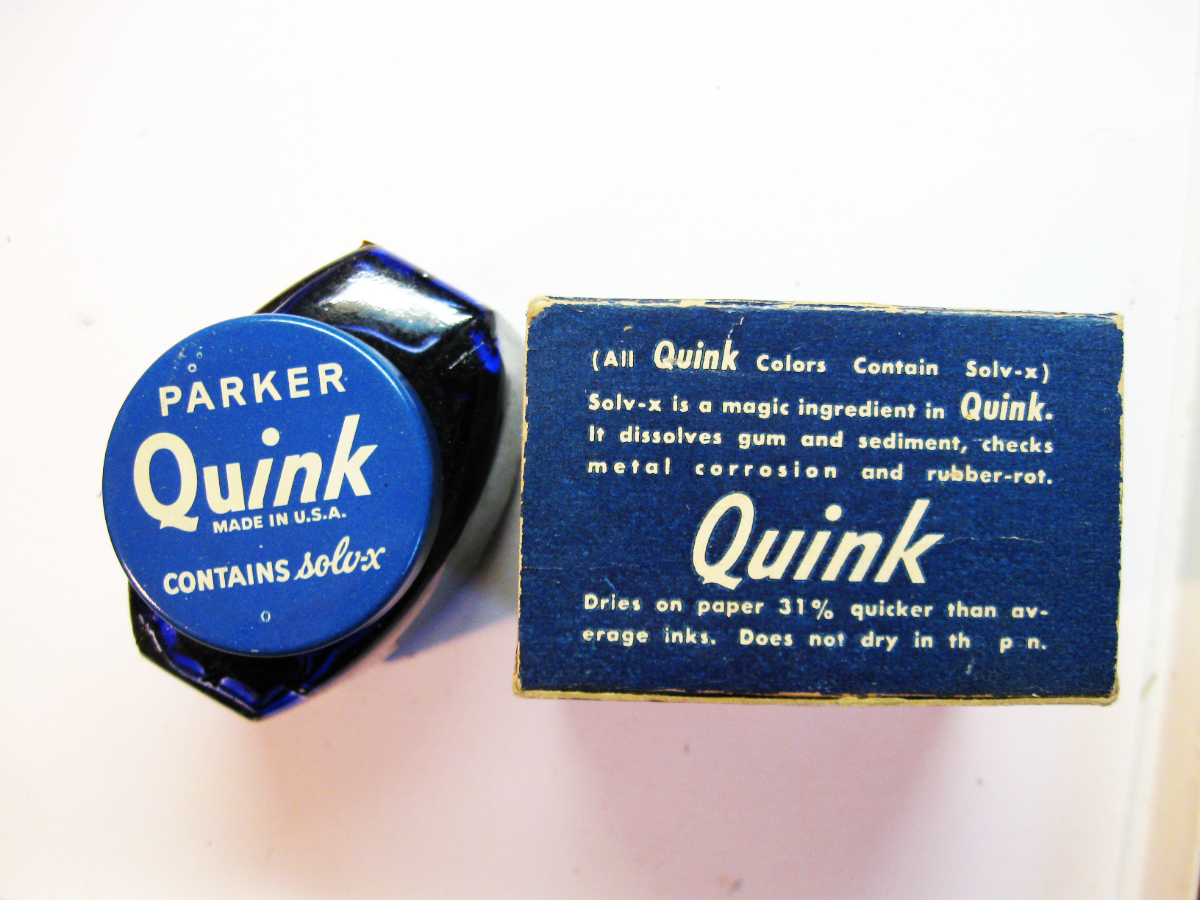
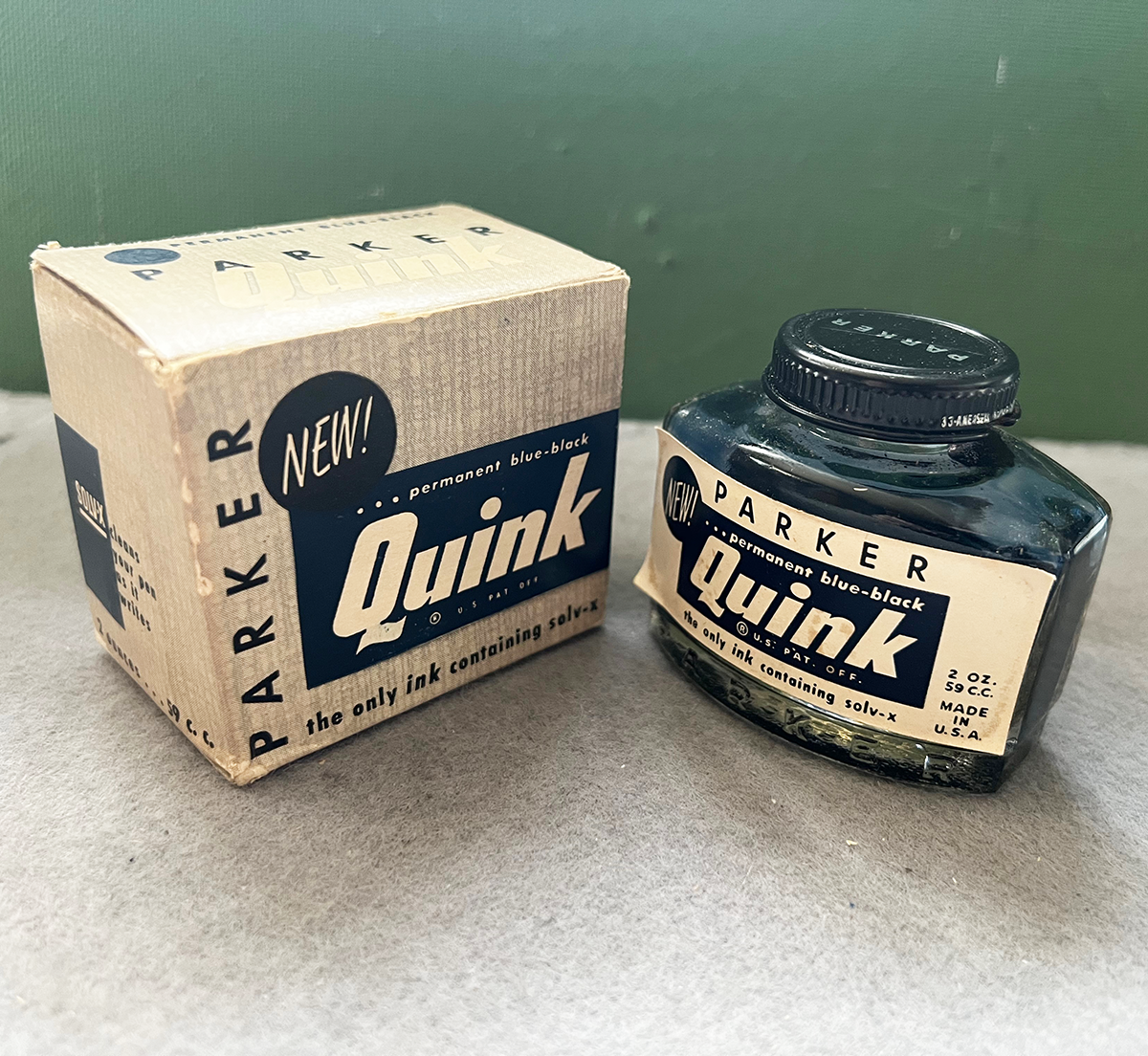
1950-1958
♦ New! Quink USA. In 1950, the box and label of the Quink bottle were updated, featuring a bold new font and the word "NEW." It’s unclear whether this referred only to the packaging, as no specific references to changes in the ink formulation have been found. The cap was replaced with a standard black metal version, which would be the last of the metal caps.
In a 1953 Parkergram, Vera Jordan wrote to Parker about her US company being burgled; the thieves stole their safe, which was later found in a creek. Despite being underwater for several days, all their accounts, ledgers, and check stubs remained legible, thanks to the Quink permanent blue-black ink used.
Initially, all five sizes and nine colors of Quink were offered, but the line was later streamlined, and the 4 oz bottle was replaced with a smaller 1 oz version.:
•1 oz (only) Permanent Black and Blue-Black
•2 oz
•16 oz (Pint)
•32 oz (Quart)
•Permanent Blue-Black
•Permanent Black
•Permanent Royal Blue
•Washablet Red
•Washable Blue
•Washable Black
•Washable Green
•Washable Violet
•Washable Brown
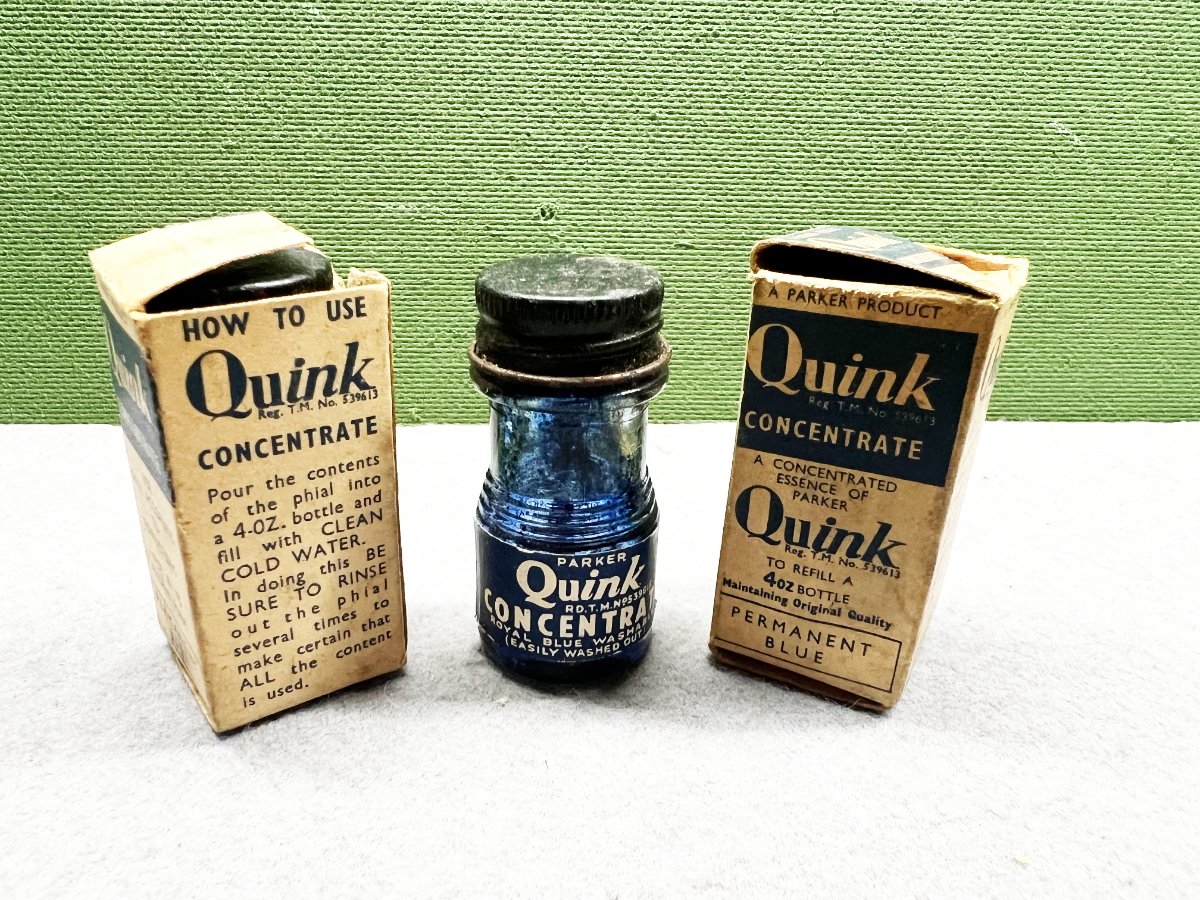
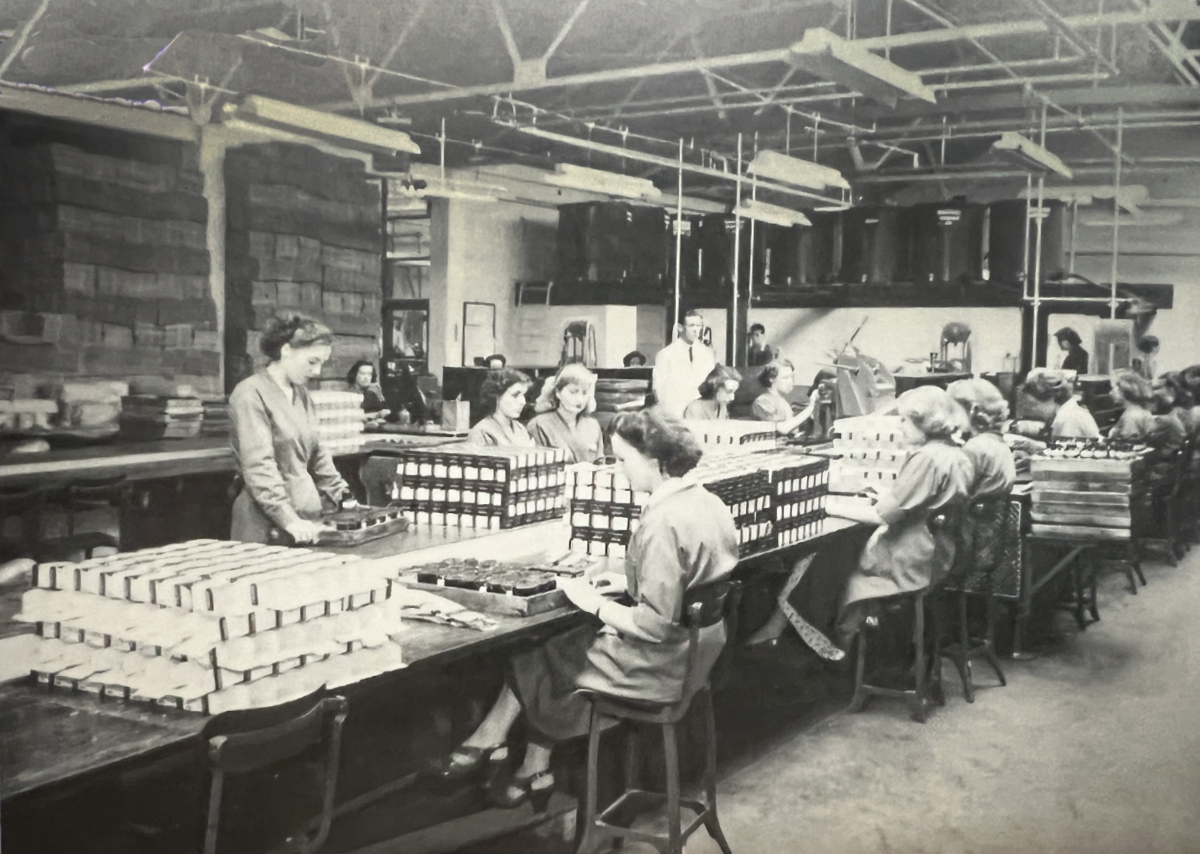
The Parker ink factory in Dover.
Quink was eventually manufactured in fifteen countries worldwide. This led to differences in the bottles. Some early bottles had cork lids, others had metal caps, and still others had plastic caps. Additionally, some caps were not threaded the same way, sometimes making it difficult to replace one cap with another. However, with the introduction of Super Quink in 1959, all caps were made of plastic.
The confusion was especially evident during the war years when Parker faced logistical challenges and material shortages. They even produced a small bottle with concentrated ink that could be diluted to make it suitable for writing. This idea wasn’t entirely new; during World War I, Parker had already offered ink tablets for troops that could be dissolved in water.
Left: The Parker ink factory in Dover.
1950-58♦ New! Quink UK. Parker opened a factory in Dover, England, after the war, and around 1950 they began producing ink for the European market. The boxes were very similar, but the UK versions were about eight millimeters taller.
Interestingly, the US boxes stated "2 ounces ... 59 c.c.," while the UK boxes read "2 ounces ...... 57 c.c." The UK bottles, and box undersides, did not state the country of manufacture, whereas the US versions were labeled "Made in U.S.A." The US bottles had black metal caps, while the UK ones featured plastic caps. The only indication of UK production was the size options: US bottles were available in pints, quarts, and gallons, while the UK bottles were offered in half-liter and one-liter sizes. Additionally, the available colors differed between the two regions.
•2 oz
•4 oz
•1/2 litre
•1 litre
•Permanent Black
•Permanent Black-Blue Black
•Permanent Blue
•Permanent Red
•Washable Royal Blue
•Washable Emerald Green
•Washable Violet
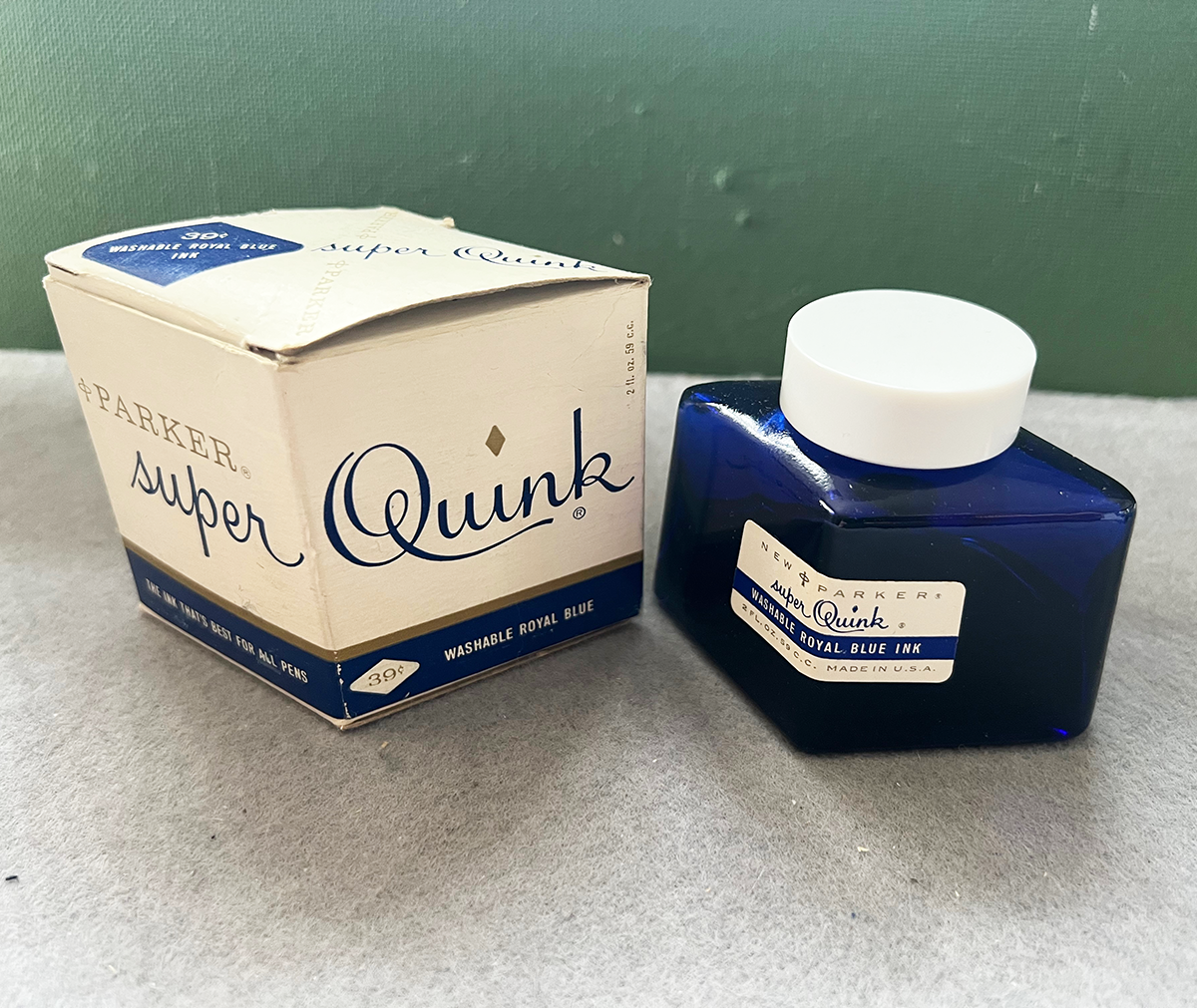
1959-c1961♦ Parker Quink US.
Super Quink was specially developed for the newly launched Parker 61. Although the exact changes to the formula are unclear, it was likely modified to work better with the new capillary filler of the "61." The ink was created by Parker’s chief chemist, Dr. Galen Sayler, who described it as: “Mix it with any acid ink on the market, ours or others’, and it will not form a pen-clogging sediment. We made it that way!” The box and bottle were designed in a distinctive diamond shape, with the bottle made of attractive cobalt blue glass with a white plastic lid.
Initially, the box displayed the text “Contains SOLV-X” on the side and offered six permanent colors and two washable ones. Later, the SOLV-X text was removed, and the washable black was discontinued. Due to high production costs, the diamond bottles were eventually discontinued after a few years.
•1 oz
•2 oz
•Pint
•Quart
•Gallon
•Permanent Blue-Black
•Permanent Black
•Permanent Blue
•Permanent Turquoise
•Permanent Red
•Permanent Green
•Washable Royal Blue
•Washable Black (out c.1960)
Robert L. Kuranz started in 1956 and spent 33 years at Parker. He was the ink specialist and worked on all ball pen and fountain pen inks as well as the ball pen grease follower, Touché refill, and improvement studies. He received one patent while at Parker. Jerry Kelly and Robert did extensive thin layer chromatography studies on all brands of fountain pen ink. These were used to aide in determining dates of written documents.
After leaving Parker, Bob worked for various lawyers authenticating written documents and helping to uncover forgeries. Bob’s most famous case was proving a “Jack the Ripper” Diary as a fake. The forger was smart enough to get ink from a Company that makes old formulations, but it had a mold inhibitor in it that wasn’t in ink in 1889. Bob Kuranz was also on the Parker Community Credit Union Board for 26 years. Jerry Kelly left Parker and used his ink expertise at the Wisconsin State Crime Laboratory. (text courtesy of David Cress)
1959-c1961♦ Super Quink UK. The diamond shapes boxes and bottles were also manufactured in the English factory in Dover, but curiously enough they were in clear glass, and not the cobalt of the US bottles. They were still nice bottles, but ... well the cobalt ones are really beautiful. There was also a different font on the boxes, and the bottle labels were also different.
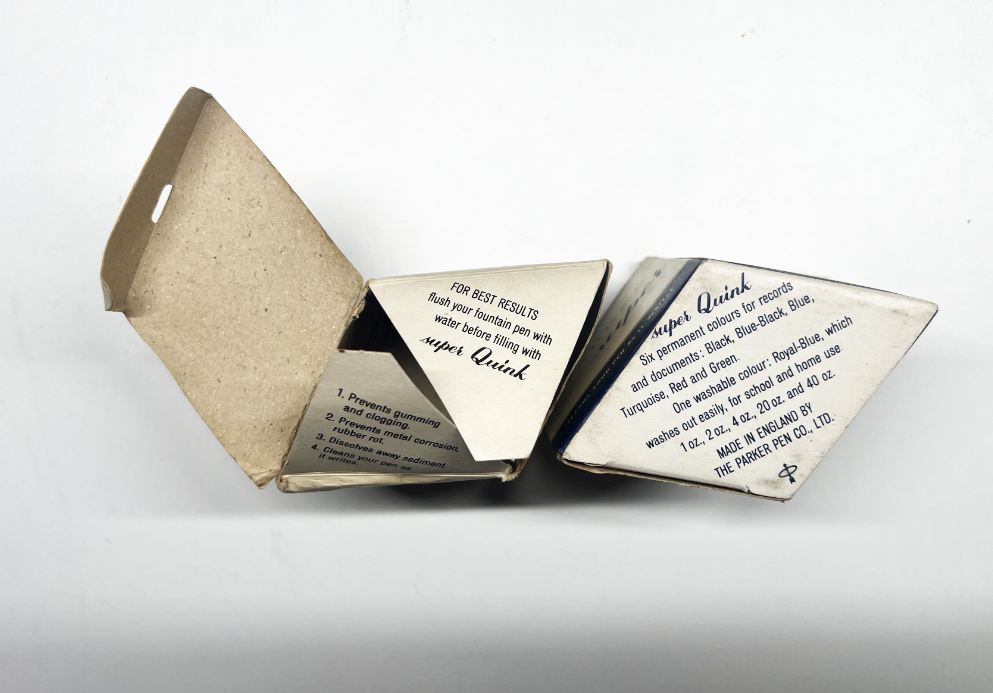
1961-1970s♦ Super Quink USA. With the discontinuation of the diamond shaped bottles Parker went back to the bottle and box type of the late 1940s with "Super Quink" on a white background with a top and bottom representing the colour of the ink, adding the parker logo in the left corner and returning to the black plastic lids.
In 1957 Parker aquired Eversharp and the rights to their cartridge pen "10 000", and subsequently introduced the famous Parker "45" in 1960. This saw a focus on the new ink cartridges, and also the ball pens, roller balls and felt tip pens was beginning to replace the fountain pens. This lead to Parker reducing the advertising for the Quink, making it harder for us collectors to pinpoint the manufacturing dates during the 1960s and 1970s.
•2 oz
•16 oz
•32 oz
•Permanent Black
•Permanent Blue-Black
•Permanent Blue
•Permanent Turquoise
•Permanent Red
•Permanent Green
•Washable Royal Blue
1961-1970s
♦ Super Quink USA. There was also a variant of the above box with the price "39c" printed above the "Super".
1961-1970s
♦ Super Quink-UK. The main difference to the US version was the text "Washes out easily" on the box and the design of the bottle label.
•2 oz
•1/2 litre
•1 litre
•Permanent Black
•Permanent Blue-Black
•Permanent Turquoise
•Permanent Red
•Permanent Green
•Washable Royal Blue
c1976-c1979♦ Quink plastic bottles USA. The last bottles to be produced at the ink factory in Janesville were the rather unattractive plastic bottles that were most likely produced between the two oil crises of 1973–74 and 1979, which made plastics expensive to produce. The first bottles were priced at 39c, just as the previous glass bottles. The plastic bottles was actually cheaper since they contained 1/2 an oz more, but that rapidly changed when the price was jacked up to 69c. It still contained SOLV-X.
•2 1/2 oz
•Permanent Black
•Permanent Blue-Black
•Washable Black
•Washable Blue-Black
c1976-c1979
♦ Quink plastic bottle UK. The plastic bottles were also produced in Newhaven, made and sold side by side with the standard glass bottle in a box, which was updated in the mid 1970s.
•2 1/2 oz
•Permanent Black
•Permanent Blue-Black
•Washable Black
•Washable Blue-Black
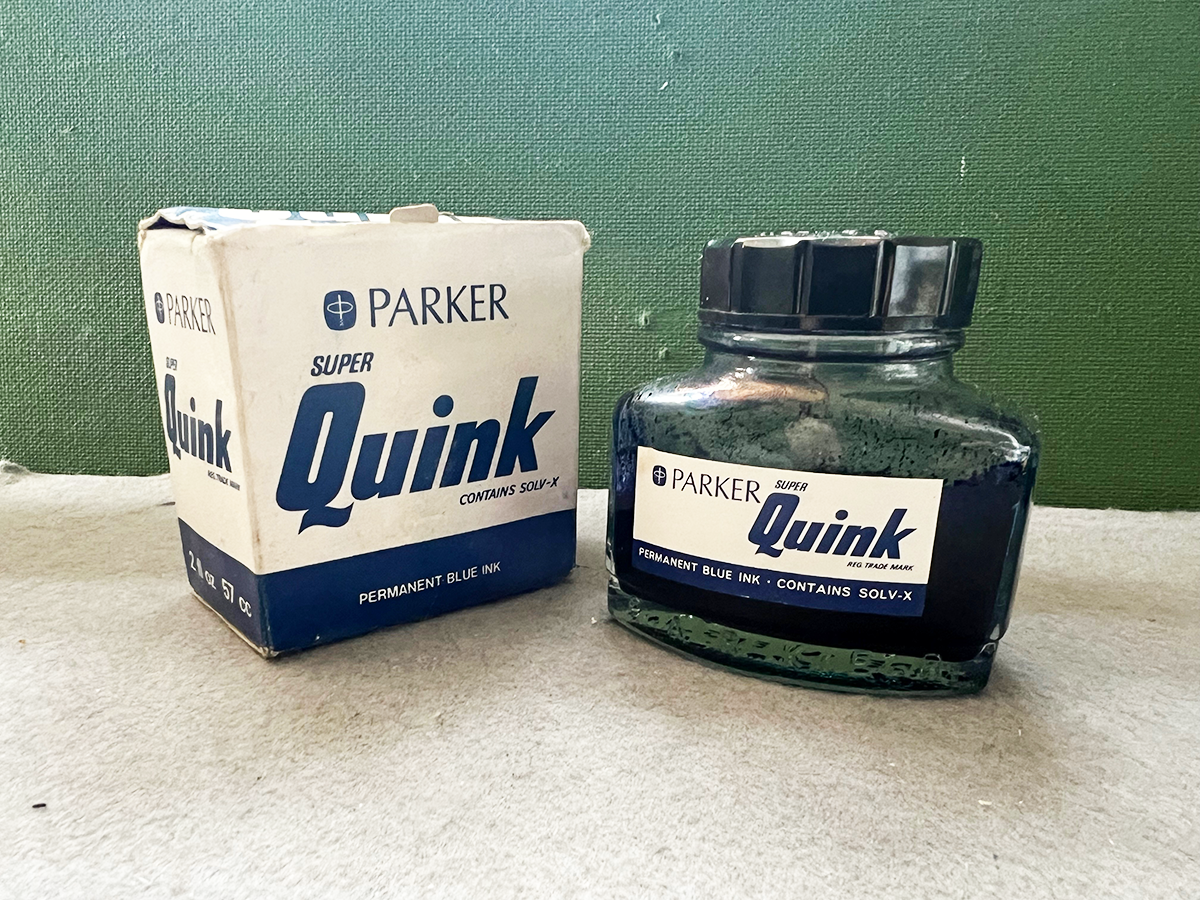
1970s-1981♦ Super Quink UK. The bottle and box were redesigned in the early 1970, Instead of having three bands in the colour of the ink the boxes lost the top one, replacing it with the logo and "Parker" in a new font. It came with the same colours as the previous glass bottles, but added Permanent Blue. This was the last ink made in the factory in Dover.
Most likely coinciding with the closing of the ink factory in Dover in 1972 and moving the production to Newhaven there was a slight change: The font at the bottom denoting the colour became smaller while the notation of sizes became larger. Also the green ink was discontinued. There was also a change in the marking on the underside of the bottles, most evident was the move of the letters "UG" (stands for United Glass, who made the bottles) from being on a single line at the bottom, to moving up after "57ml". There was also a change in the sizes offered.
•Permanent Black
•Permanent Blue-Black
•Permanent Blue
•Permanent Turquoise
•Permanent Red
•Permanent Green (until c1972)
•Washable Royal Blue
•1 oz (until c1972)
•2 oz
•4 oz (until c1972)
•20 oz
•40 oz (until c1972)
1982-87
♦ Super Quink UK. In 1982 the design of the boxes changed again, while the bottles stayed the same. It sported a large circle representing the colour of the ink. The logo and "Parker" became larger, and a bar code on one side and "Cleans your pen as it writes" on the other. The Turquoise ink was discontinued and there was only one remaining bottle size.
•Permanent Black
•Permanent Blue-Black
•Permanent Blue
•Permanent Red
•Washable Royal Blue
•2 oz
1988-1999
♦ Quink UK. In 1993 Gillette bought the Parker Pen Company, and there were a lot of changes, among other things a new ink was introduced, the Penman (see below), but the Quink introduced in 1988 was continued to be offered side by side with the Penman. It was the last ink to contain SOLV-X.
•Permanent Black
•Permanent Blue
•Permanent Blue-Black
•Permanent Red
•Permanent Turquoise (from 1992)
•Permanent Green (from 1992-99)
•Permanent Brown (from 1999)
•Washable Royal Blue
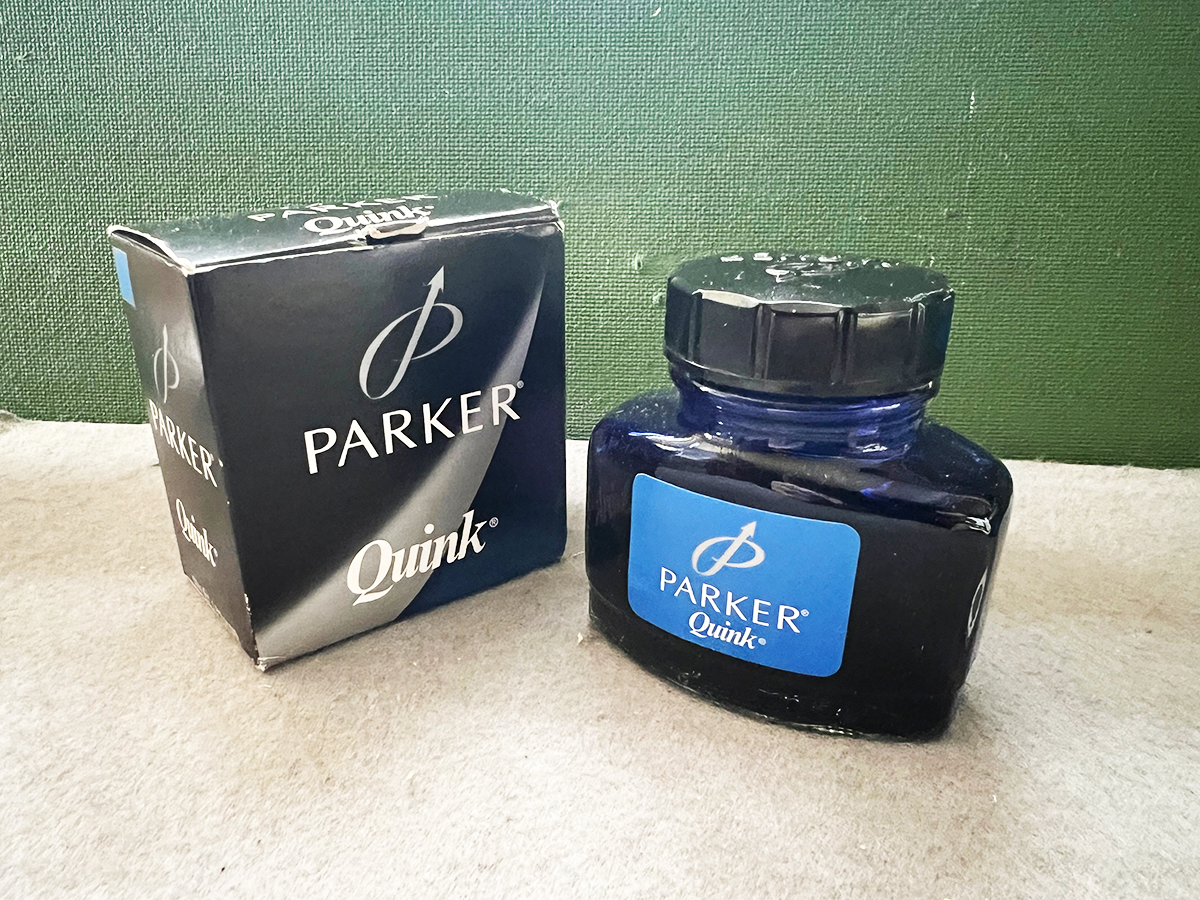
2000-2009♦ Quink UK/France. In April 14, 2000 Parker was sold again, this time to Sanford (renamed "Newell Custom Writing Instruments" in 2019), a division of Newell Rubbermaid, which today also owns Waterman, Reynolds, Paper Mate, Rotring and Sharpie. Gillette had redesigned the Parker logo into a stylised "P" keeping the arrow, but otherwise not similar to the old logo. The trademark was filed in July 1999. They also redisigned the Quink box and bottle label. The box, introduced in January 2000, now came in black, with a small square on the top lid denoting the colour of the ink. The first boxes referred to "The Gillette company" on the underside, but subsequent boxes were marked "Sanford". interestingly enough the boxes stated that the ink was made in England, but the Sanford bottles were made in France. The rather simple bottle labels stayed the same. This was the first ink without SOLV-X.
•Permanent Black
•Permanent Blue
•Permanent Blue-Black
•Permanent Red
•Permanent Green
•Washable Royal Blue
•Washable Black
2005-2009
♦ Quink France. Around 2005 Parker (now owned by Sanford) began producing Quink in the old Waterman factory in Saint Herblain, Nantes in France. The boxes differed from the ones made in Newhaven, but they used the same french bottles. The boxes had "Sanford" and "Made in France" on the underside.
2010-2015♦ Quink France. After the factory in Newhaven was closed in 2010 all ink production for the European and US markets were moved to France. There had been much dissatisfaction with the "P" logo and Parker now decided to go back to a modern version of the recognisable arrow through an oval (which are actually the two "P"s in Parker Pens, one P reversed - first used in 1958). This new logo was filed as a trademark in 2009.
•Permanent Black
•Permanent Blue
•Permanent Blue-Black
•Permanent Red
•Permanent Green
•Washable Royal Blue
•Washable Black
2016-
♦ Quink France. The box was redesigned again in 2016. Parker was awarded a Royal Warrant by Queen Elizabeth II in 1962, and by Charles, Prince of Wales in 1990. Now in 2016, coinciding with the Queens 90th birthday, Parker put the warrant on the lid of the new grey box. In May 2024 King Charles renewed the warrant yet again for the Parker Pen Company. It has yet to appear on the lid. All but four colours were discontinued.
•Permanent Black
•Permanent Blue
•Permanent Blue-Black
•Washable Royal Blue
♦ There have been three sizes of the "new" bottles, now only the middle one remains.
Chinese Quink.
2021-current
♦ Quink China. In 2021 a very attractive collection of Quink ink was offered, unfortunately only to the Asian market. They came in small, square boxes with the Royal Warrant on top, and the 30 ml bottles were also square with large lids. The underside reads "Ink from France, bottled in China". Possibly in Shanghai. The box on the left is just for size comparison.
♦ Quink China.
•Green Jade
•Ocean Blue
•London Red
•Turquoise Lagoon
•Purple Bloom
•Cocoa Brown
•Black Original
Parker "51" and Superchrome ink.
After the success with Quink the two chemical engineers Gaylen Sayler and Carl S Miner still had it in their minds to create an ink that dried even faster. Most inks were acidic at this time but they realised that an ink with a highly alkaline base including isopropyl alcohol could give them what they were looking for. Unfortunately both these features were notorious for destroying plastics in general and celluloid pyraline in particular, and Parker's best seller, the Vacumatic, was made in celluloid. They argued to Kenneth Parker that if the pen couldn't handle a better ink, they needed a better pen. They turned to the plastics company DuPont to find a more suitable plastic that could cope with the new ink. They came up with polymethyl methacrylate, sold under the name Lucite. It was, among other things, used in making parts for aeroplanes. This eventually became the preferred material for the new Parker "51" pen. Thus it was the ink that created the necessity for the new pen that was destined to take over the world.
The main selling point for the new ink was that it would "Write dry with wet ink". It was highly waterproof, eliminated smudging and blotting, and the colours were intense and permanent, to the point that Parker warned against getting the ink on clothing because there was no known way to remove it if it wasn't cleaned immediately. If at all, since it dried by penetration, not evaporation. Parker included cleaning advise in every package. It also reacted badly with other ink, immediately clogging the pen up if it wasn't cleaned before filled.
1941-47♦ Parker "51". Parker called their new ink made especially and solely for the "51" pen for "the most important invention for writing convenience in the last 50 years", at the same time they posted a warning: "This ink will not work safely or satisfactory in any other pen". According to David Shepherd in his book "Parker "51" the new ink was initially marketed as "Double Quink" in 1939, but was renamed for the launch in 1941 simply to "Parker '51' ink".
But it was soon clear that the corrosive qualities of the ink was a problem. So in 1947 a new version called "Superchrome" was introduced.
The Parker "51" ink came in very attractive boxes, 3 oz bottles and was offered in four colours:
•India Black
•Tunis Blue
•China Red
•Pan-American Green
♦ Two sizes of the Parker 51 ink.
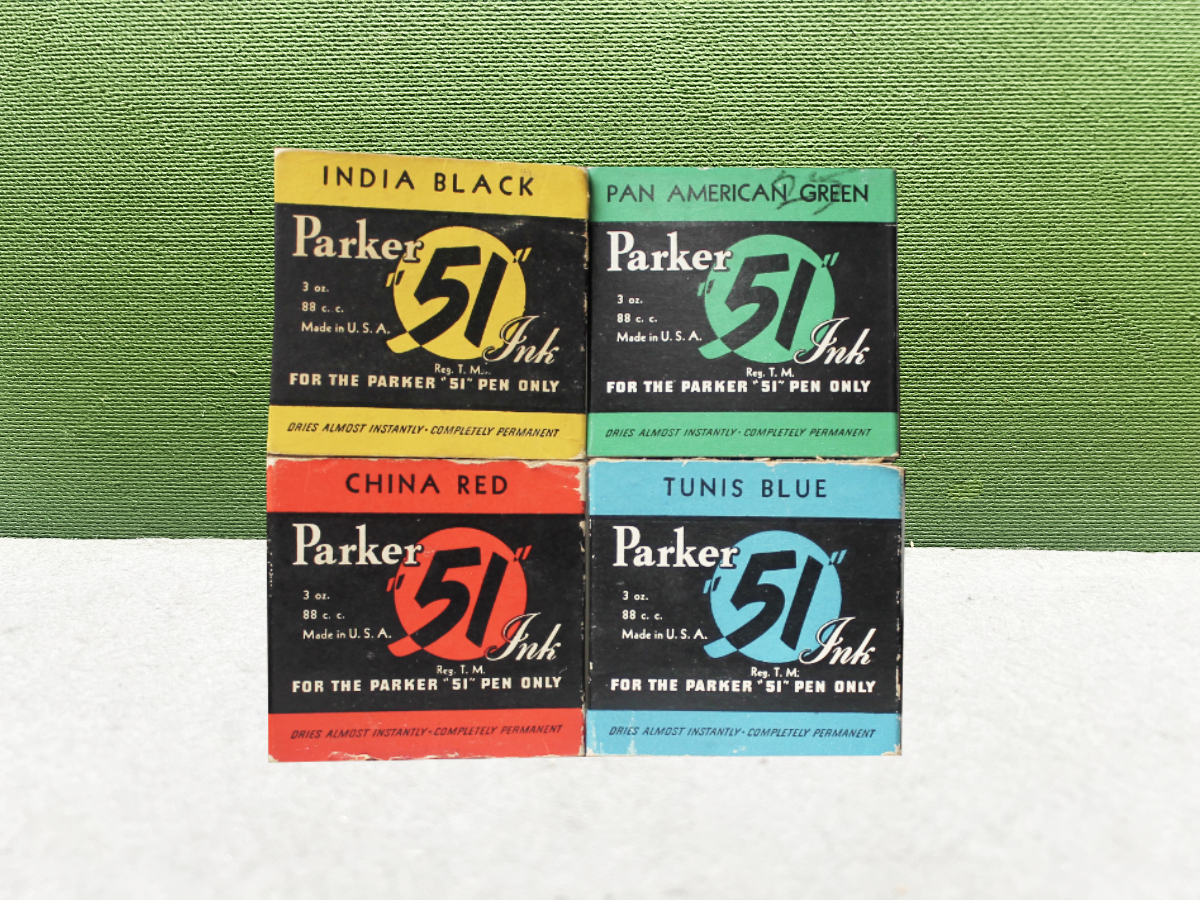
♦ The four colours of the Parker 51 ink.
When the Parker "51" ink was introduced the "51" pen also utilised the Vacumatic filler, and it turned out that the "51" ink in time rotted the rubber ink diaphragm. So Sayler and Miner adjusted the formula and Parker later offered a milder, updated ink which was called
Superchrome, which could still only to be used with the Parker "51" pen. Within a year Parker introduced the new aerometric "51" pen which had an ink sac made in what they called
Pli-glass made from polyvinyl chloride (PVC), known for its durability and chemical resistance.
Superchrome was a combination of 0.02% amyl xanthate, an organosulfur compound used primarily in mining that makes metals hydrophobic, helping the ink to leave the nib making the ink run smoother from the pen, and 1.3% sodium hydroxide (caustic soda), which helps adjust the pH to prevent corrosion and improve ink flow by reducing acidity. Bentonite, a kind of clay, was also added to help the ink disperse evenly and prevent clogging. It also reduced feathering and blotting by helping the ink adhere better to paper. Another component was ammonium metavanadate (0.35%), which acted as a pH buffer, protecting against unwanted chemical changes.
1947
♦ Superchrome. The new Supercrome ink was patented and introduced in september 1947.
The first boxes were made in very attractive aluminium. They contained large 4 oz bottles that didn't have a label, but the bottle cap said: "Parker Superchrome Ink", and the box contained a small folder showing "how to fill your Parker '51'". Curiously enough, beside the "normal" "51" with the Vacumatic filling system it also depicted the illusive "Red band" Parker "51" which had a filling system that really didn't work and the pen never left the test market.
•Super Black
•Super Blue
•Super Blue-black
•Super Red
•Super Green
1948-49
♦ Superchrome.
Unfortunately the previous aluminium boxes proved too expensive and complicated to produce, so within a year Parker replaced it with a new box, made in cardboard. It was silver coloured to gave the impression of being in metal. It even had the same folder boasting "Smartly packaged in metal for your protection". But even these boxes were only around for a couple of years. It came in the same selection of ink colours.
1949-57
♦ Superchrome. In 1949 Parker again decided to change the look of the Superchrome ink. They turned to a Chicago designer, David Chapman, (who also designed one of the nicest boxes for the Parker "51" pens). He came up with a plain white ink box with part of a "51" pen pointing to a large "S" in the colour of the ink. This design earned him an honorable mention by the Folding box association of America. The text on the lid was: "for the Parker "21" and "51" pens ... only".
It was offered in
•Turquoise Blue
•Jade Green
•Blue-black
•Red
•Jet Black
1958-59
♦ Superchrome. Perhaps because the "Parker" brand name was not very prominent the large "S" was removed, and a much larger "PARKER" was added on the front. Curiously the warning not to use the ink with pens other than the "21" and "51" was also removed and the font changed, "Superchrome" now in italics. The Label on the bottle also followed this design. It was however offered in the same colours as previously. The Superchrome was phased out with the introduction of the Parker "45" pen that utilised the new ink cartridges.
Parker Penman.
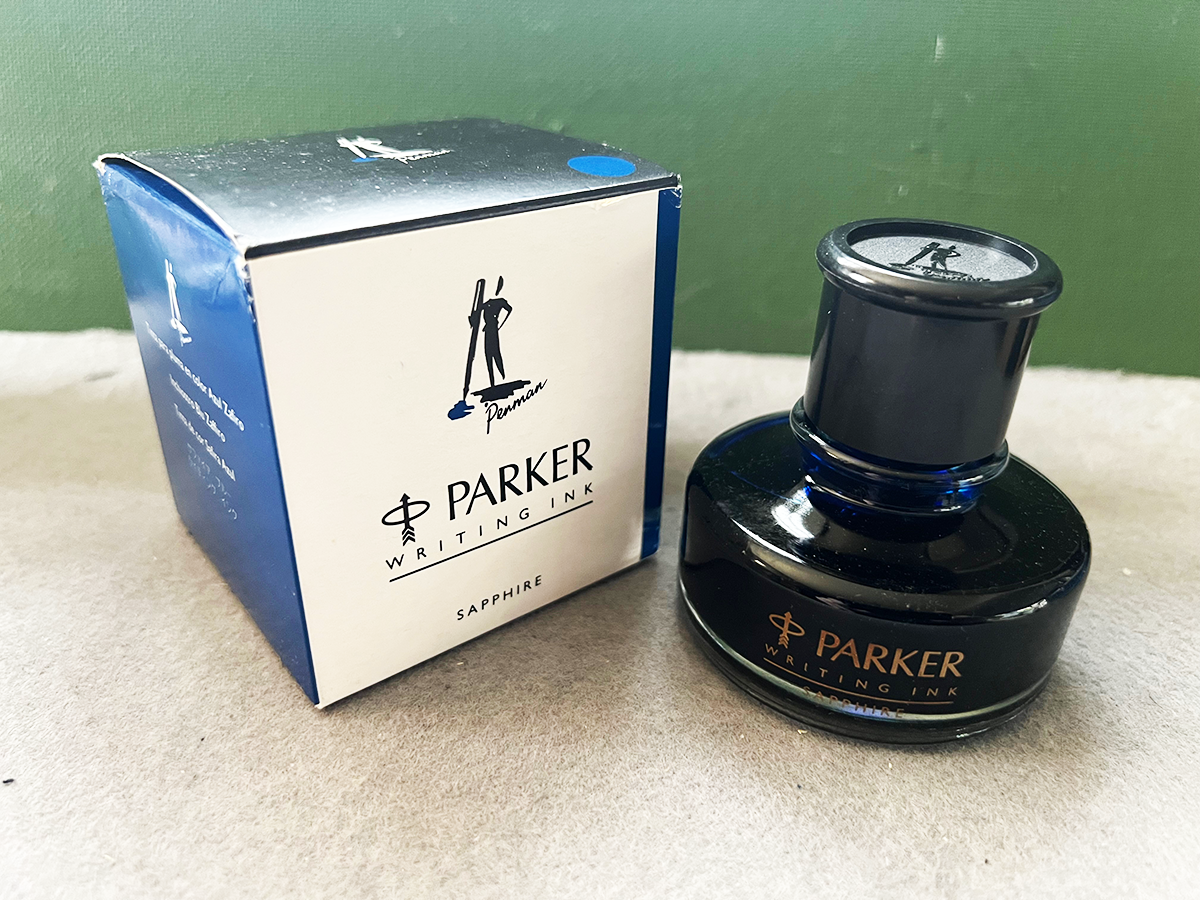
1993-1998♦ Penman. In 1993 Parker introduced the first new ink since the 1940s. The Penman ink came in newly designed, very attractive, round ink bottles with a large cap which made opening them easy, and inside there was a small plastic container that made filling pens easier. You turned the bottle upside down to fill the container, and that also made it easier to use even the last ink in the bottle. The ink itself was very saturated and quickly got good reviews for it's vibrant colours. There was however problems with the black ink. Like most ink for hundreds of years what made it black was the usage of carbon, in essence soot. This was normally not a problem, but the richness and high saturation of the colour made it prone to clogging. This wasn't really a problem with a pen that was used every day, but if it had been lying around for a few days the ink dried, rendering the pan useless unless you cleaned it out. This gave the Penman ink a bad reputation and after only five years Parker decided to discontinue it. But many users were horrified by this decision. Especially the Sapphire is still coveted by collectors on account of its beautiful and distinct blue colour, and has become something of a holy grail. Full bottles of Penman Sapphire have been known to fetch $150 and more on auction sites. The bottles were made in England.
The colours were:
•Ebony Black
•Emerald Green
•Mocha Brown
•Ruby Red
•Sapphire Blue
2000-2007
♦ Penman. For years after the main discontinuation Parker used to include a bottle of Penman in the boxes of some limited edition pens, and when Sanford took over the company they resurrected the ink, now made in Shanghai. It was offered in two colours only, Black and Blue. It is possible that they altered the composition of the ink leaving it less saturated. It's also unclear if the blue was indeed Sapphire or some other colour. The Chinese bottles (although made in England) were more oval and came in a shiny black box with the "P"-logo. The underside of the box read: "Manufactured by Parker Pen Shanghai Limited, China" and had the Sanford logo.

Special thanks to David Shephard, Richard Binder and Dan Zazove.
(Updated 2024)

